How the Most Popular Sailboat Ever Was Invented
The Sunfish taught millions of Americans to seize the breeze
Kate Wheeling
:focal(1241x827:1242x828)/https://tf-cmsv2-smithsonianmag-media.s3.amazonaws.com/filer_public/49/07/4907326a-a85c-4721-86a1-c951e3faa780/julaug2023_g26_prologue.jpg)
It's the platonic ideal of the sailboat, unmistakable in lakes and coastal waters across the country, with its colorful, equilateral triangle sail pulled taut in the summer breeze. It’s also the most popular sailboat ever made, with more than half a million built since the first launch in 1952.
The design of the Sunfish came from Cortlandt Heyniger and Alex Bryan, friends whose company, Alcort, was building a rescue paddleboard for the Red Cross. On a whim, Bryan added a simple sail to the wooden board to create a basic but elegant sailboat. As legend holds, his wife, Aileen Bryan—née Shields, a sailing scion and racing champion—tried sailing the craft and wanted a little more room to maneuver, as she was then pregnant. So Alcort’s first employee, Carl Meinert, designed a cockpit for the Sunfish, drawing the first mock-up in dust on the floor of Alcort’s woodshop in Waterbury, Connecticut. The first Sunfish was built in the early 1950s.
The first models were wood and measured just under 14 feet long. They sold for less than $200—roughly $2,200 in today’s dollars—and could be launched right from the beach without a dock, making the Sunfish an accessible and affordable fixture at vacation houses across the United States.
The Sunfish also opened up the world of sailboat racing to those who could not afford yachts and club memberships: 1963 saw the first North American championship for Sunfish racers, and the first Sunfish World Championship was held in the U.S. Virgin Islands in 1970. The boat’s simplicity meant winning was truly a testament to one’s skills; as one Sunfish dealer told the New York Times in 1970, “Racing one puts a lot on the man.” Or woman, adds Lee Parks, a two-time winner of the women’s North American national championship: “Unlike some other classes, the Sunfish class is male and female. It’s multigenerational. Anybody can sail them.” In 1977, Fortune magazine named the boat one of America’s 25 best-designed products. The Sunfish designers were inducted into the Sailing Hall of Fame in 2021.
Sunfish enthusiasts, whether casual sailors or serious racers, are known for their sportsmanship. According to Parks, “Every event you go to is like a family reunion.”


Subscribe to Smithsonian magazine now for just $19.99
This article is a selection from the July/August 2023 issue of Smithsonian magazine
Get the latest stories in your inbox every weekday.
Kate Wheeling | READ MORE
Kate Wheeling is a former staff writer at Pacific Standard .

Published on April 16th, 2018 | by Editor
Sunfish: The True Love Boat
Published on April 16th, 2018 by Editor -->
Sports Illustrated magazine has been serving sporting enthusiasts since 1954, and had this gem in its vault from their magazine issue dated September 20, 1982 :

And they go on to become legends in their own time—famous and rich, paragons of the capitalist establishment—the Eli Whitneys, the Thomas Edisons, the Henry Fords of their day, freckle-faced examples of the best that the American Dream could ever hope to produce. And not only that, their product is designed to do nothing but make people happy!
That, in slightly different form, is the story of Alcort Inc. and its two founders, Alexander Bryan and Cortlandt (Bud) Heyniger (the Al and the Cort of the firm name), both now 69 years old. They got together after World War II in the loft of a lumberyard in Waterbury, Conn. and eventually invented and mass-produced the Sunfish, which is the most popular sit-down-and-ride-in-it sailboat on the planet.

Almost twice as many Sunfish have been sold as its closest competitor.
Sometime last spring—or maybe it was early summer—the 200,000th Sunfish was sold. No one knows when it came off the production line, and no one knows where it was shipped; in fact, no one is sure of anything about the 200,000th Sunfish except that it was produced this year.
The reason for all this uncertainty is that, believe it or not, no one knows when Alex and Cort began making them—1951? 1952? 1954? (The best bet is 1952.) Like good red-blooded B-movie heroes, the Alcort boys were more interested in the raw-meat stuff of production results than they were in the dull, dusty chore of keeping accurate books or records.
The second-most-popular sailboat is the Laser (a 14-foot, high-performance racer) with sales of just over 100,000, followed by the Hobie Cat 16 (the zippy catamaran designed by Hobie Alter) with 75,000. The Windsurfer, the stand-on-it sailboard which swept across American waters in the late 1960s and early 1970s and spread to Europe with similar impact more recently, now outnumbers all manner of wind-propelled craft, with roughly 250,000 in use.
But the sailboard isn’t a true sailboat.
For years, brassbound racing salts and lots of weekend sailors, perhaps suffering from delusions of their own grandeur, have looked on the Sunfish as little more than a beach toy. There is plenty of evidence to refute this, of course. World class racers such as Dennis Conner, of America’s Cup fame, and Gary Hoyt, who developed the Freedom class and won the first Sunfish Worlds in 1972, learned to sail at the slim wooden tiller of the Sunfish.
This year the class had its 13th World Championship, at San Mateo, Calif., on the choppy waters of San Francisco Bay. There were 71 competitors from no fewer than 21 countries. The Sunfish class is officially recognized by the U.S. Yacht Racing Union (now US Sailing), and the international union (ie, World Sailing) is expected to accept the class soon. Sunfish racing is by no means confined to the U.S.
Racing sail numbers have been issued to 55,000 Sunfish owners, and there are registered fleets all over the world. Oddly enough, the largest fleet is in Saudi Arabia, where an armada of 300 flits about the Persian Gulf, skippered by every type of individual, from expatriate American oil worker to oil-rich Arab aristocrat.
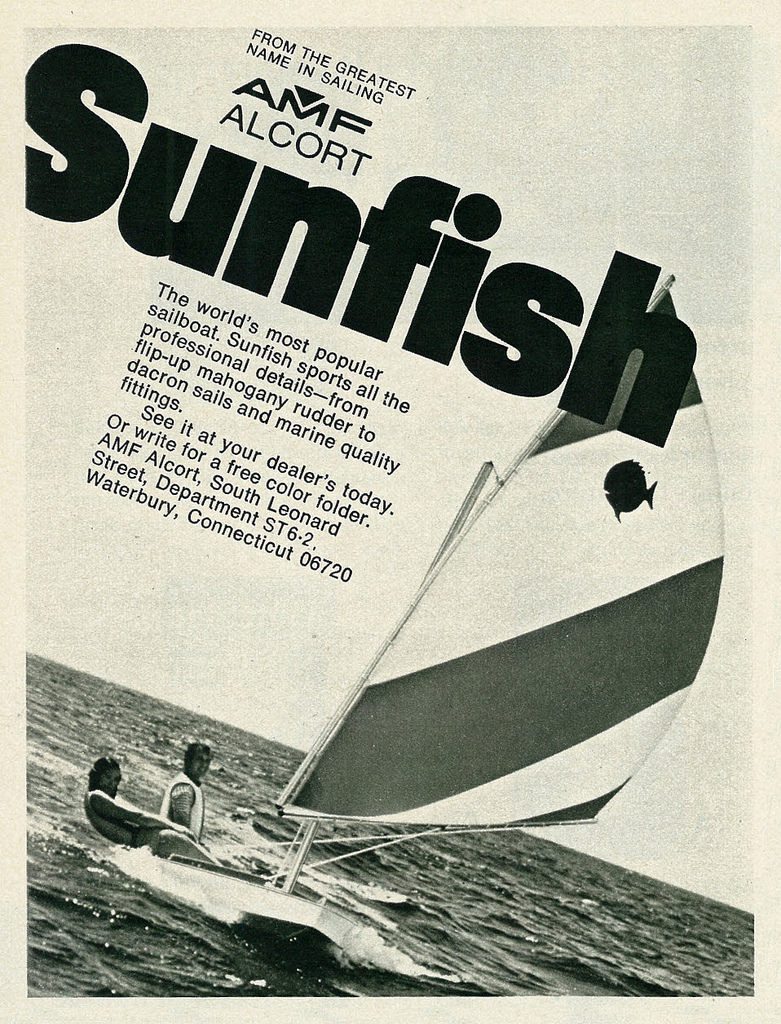
Obviously, the appeal of the Sunfish—which costs only $1,259 and can be sailed by a reasonably smart 6-year-old—cuts through a lot of social, economic and ethnic strata. This fall The Sunfish Book will be published by Sail Books. The author is a Hartford p.r. man and sailor named Will White, 52, who was the North American Sunfish champion in 1966 and 1968.
According to White, “The Sunfish is pure sailing—the sail in the wind, the board in the water, and you in the hull in between—one hand on the tiller, the other on the sheet and the wind in your hair. Pure sailboat racing, too. For the racing sailor, it is the essence of yacht racing.
“It was the first truly one-design boat, rigidly controlled by the manufacturer, with even the sails limited to one loft and very little that could be done in the way of adding expensive go-fasts. No need for a new set of sails every year. No need to keep buying or changing expensive hardware to keep up with the latest sailing theory. Even if you attach the best of everything allowed by the class rules, you’ll have a hard time spending more than $100.”
Whether for racing or recreation, the Sunfish has come to be one of our more familiar images—almost as recognizable a symbol of carefree vacations and sunshine fun as Santa Claus is a symbol of Christmas. It’s said you can’t watch a TV screen anywhere in the U.S. for 24 hours without seeing at least one Sunfish go by.
The saucy little boat has appeared on enough Sunday-supplement covers to rank right up there with puppies and Princess Di. It has come to be the prescribed jolly beach backdrop for print ads and TV commercials from Air France to S&H Green Stamps, from Buicks to Wamsutta sheets, from the National Geographic Society to tourism in the state of Utah.
When Bryan was asked to explain this phenomenon, he said, “I think there’s something friendly about the appearance of these boats. Something unpretentious. Nobody is ever jealous of a Sunfish, and I think that probably works to make other people’s products not look snobbish.”
Whatever the reason, the Sunfish is everywhere, and one never knows where it might pop up. In 1968, the tiny island of Montserrat in the British West Indies issued a 5¢ stamp honoring the Sunfish, and two years later the Bahamas came out with a 12¢ Sunfish.
In 1959, FORTUNE picked the 100 best-designed products of all time—including such classics as the Model T Ford, the Kodak Brownie, the Rolls-Royce Phantom II and the Ben Franklin iron stove. The Sunfish was a very new product then, and it didn’t make the grade in that august company, but when FORTUNE came up with a new list, in 1977, of the 25 best-designed contemporary products, the Sunfish was right there along with the Trimline Touch-Tone telephone, the Porsche 911 S Targa and Adidas running shoes.
But all of this high-tech accolade and worldwide marketing clout isn’t really the Sunfish story, not at all. No, its origins lay in the minds of “two nice guys sitting in the middle of a pile of shavings,” as a Hartford adman described them after his first sight of the Alcort partners in the 1950s. Bryan and Heyniger were boyhood pals who began collaborating as builders with a collection of “huts,” the Waterbury version of the classic tree-house or clubhouse.
The Alcort boys were into super-huts—one was three stories high and had running water—as well as even more complex projects. “We built a glider once, but it wouldn’t fly, not even with our lightest friend,” Heyniger recalls. They never had any formal training in woodworking—”We sort of taught each other,” says Bryan—but they were obviously smitten with the craft at an early age. As Heyniger said recently, “The best Christmas present I ever got as a boy was 10 pounds of nails.”
Bryan and Heyniger went to different prep schools (Lawrenceville and Hotchkiss) and different colleges (Yale and Dartmouth) but they both wound up in the late 1930s caught in the backwater of the same Depression. Bryan ended up at the Scovill Manufacturing plant in Waterbury as an apprentice machinist, and Heyniger went to work on the production line at the Waterbury Buckle Company for 35¢ an hour.
In the autumn of 1941 they built a single-seater iceboat, then six more like it. The winter of 1941-42 provided, in Cort’s memory, “the best iceboating in history.” They had a ball on the lakes around Waterbury, but then World War II intervened. Bryan flew with the Army Air Corps Reserve in South America, and Heyniger joined the Navy and served in both the European and the Pacific theaters.
Four years later they went home to Waterbury. While they were gone, Bryan and Heyniger had learned that the barn in which they stored their beloved iceboats had burned to the ground. Fortunately, the barn and its contents were insured and the boys had some money coming, roughly $5,000. While they were at war, Bryan had written Heyniger to tell him of the insurance money and to suggest that they go into business together. “Let’s build something,” he said.
For their iceboat business they picked a perfect spot in the winter of 1946—the ice-cold loft over a lumberyard. The place was heated by two oil stoves but got so cold at night that sometimes glue would become as brittle as glass. But the rent was only $75 a month. The first thing they did was choose a name for their company.
“We thought Alcort sounded a lot better than Cortal,” says Bryan, “and also we knew that it would come first in the Yellow Pages.” And that was about as sophisticated as merchandising got around Alcort back then. The boys were much more interested in the excitement of big-time, full-capacity production, so, says Bryan, “We went downstairs to the lumberyard and bought planks for a workbench, and then to the hardware store across the street for some tools.”
Their first order wasn’t for an iceboat: It was for a dozen wooden drawer pulls, at 10¢ each, for Heyniger’s girlfriend. But they did get into the boat business that winter, building seven iceboats of plywood and Sitka spruce. They also began to make rowboats. They sold some, but for all of 1946 they grossed only $4,700.
In early 1947 they hired their first employee, a gangly local kid named Carl Meinelt. Boats didn’t bring in enough revenue, so they branched out, making other things, such as portable ironing boards, baby swings that hung in doorways and a child’s game called the Klickity-Klack Marble Track.
The big breakthrough order that ultimately set them to making sailboat history wasn’t very impressive at first glance. A man from the local Red Cross came by and asked if they could make a small surfboard for lifesaving use. He had a plan, and Alcort came up with an estimate of what it would cost—around $75. The Red Cross man said the price was too high, and left. Meinelt says with a wink, “I think he really wanted us to do it as a contribution to the Red Cross.”
As it turned out, it was the Red Cross that made the contribution to Alcort. “He made the mistake of leaving the plans behind,” says Heyniger, “so we decided to make a surfboard anyway. Then Alex put a triangular Old Town canoe sail on it, and we stuck on some aluminum bars. It was only 22 inches wide, and we couldn’t make it do anything. We needed more beam, so we made another one 32 inches wide. I could never get it to work at all. Carl was more agile, but it was still like trying to sail a log.”
Finally, after fiddling around with several models, they installed a rudder and a dagger board and widened the beam to a manageable 36 inches and the length to just short of 14 feet. They kept the equilateral triangle sail. And the boat worked just fine.
They first called it the Sailboard, but that seemed fairly uninteresting, so they picked Sailfish—possibly because, as Heyniger recalls, “The thing sailed under the water about as much as it did on top—which was like a sailfish.” Something like that.
When White asked Heyniger how much the company had charged for the first Sailfish, Cort just wasn’t sure. “We didn’t keep records,” he said. “We’d get so cluttered up with stuff that we threw a bunch away. But I think the first Sailfish cost $128.50. The first Sunfish, I think, was $200—no, $195. To keep it under $200.”
Despite the change in the name, the Sailfish was in fact a’ sailboard. A person sat on a flat surface, legs stretched out in front, with the sheet in one hand and the tiller in the other, and had a very wet ride.
The early models were made of plywood and the buyer had a choice between a readymade boat or a cheaper do-it-yourself kit. This made for some wildly varied finished products. Heyniger recalls, “The brochure suggested that a kit could be assembled in a few dozen hours, but a real perfectionist could spend a whole winter at it, while some people slapped them together in no time and they’d have leak problems for the rest of their life. We found some people were installing screws with a hammer instead of a screwdriver.”
Alcort started selling Sailfish in 1947 and moved about 100 the first year. “We knew practically every customer by his first name,” Heyniger says. But they were beginning to think a little bigger and they contacted an ad man, who wangled a very small patch of space for their very small boat on the floor of New York City’s Grand Central Palace, where the 1948 New York National Boat Show was being held.
Fortuitously, the Sailfish—that cute little wood chip with its perky lateen sail—wound up sitting right next to a 57-foot Wheeler yacht, the largest boat in the show. The glorious contrast between the two made the Sailfish the talk of the town.
That was excellent, if accidental, p.r., but the big coup—the thing that “really put the ointment in the fan,” as Heyniger says—occurred in August 1949, when LIFE magazine ran a double-page photograph of a Sailfish skimming along on a lake near Madison, Conn. In those days the clout of LIFE was so enormous that Alcort’s phones nearly fell off their hooks with calls from excited customers.
And was that all-important LIFE story the result of smart, sophisticated pressagentry on the part of Alcort’s marketing geniuses? Certainly not. It was just as refreshingly unpreconceived as everything else about the outfit.
Some friend of Bryan’s or Heyniger’s (no one recalls whose) brought a weekend date to Connecticut and introduced her to the Sailfish, which she loved. Lo and behold, she turned out to be a LIFE editorial researcher who returned to Manhattan and suggested a picture spread on the Sailfish—and nothing was ever quite the same again in Alcort’s lumberyard loft.
When the story ran, Heyniger was vacationing in the South and Bryan sent him this telegram: LIFE’S OUT. WE’RE IN. ALL’S FORGIVEN, COME HOME.
It was beautifully clean-cut innocent stuff—nice guys finishing first and all that. Bryan recalls, “It was a wonderful experience. Everyone was rooting for us. But, you know, we can’t take real credit for the Sailfish. We literally stumbled into it and we were lucky every minute of every day.”
Possibly so, but they were turning Sailfish out by the dozen—efficiently and swiftly. Whereas business had been so miserable that at one point the partners had gone without their own salaries—50¢ an hour each—in order to keep their books balanced, now the company revenues began to climb. Both had been bachelors when they started Alcort, but as times improved, so also did their matrimonial prospects.
Bryan married Aileen Shields, a good sailor herself and the daughter of the famed Cornelius Shields, the first man to win the Mallory Cup, the symbol of the national sailing championship. Heyniger married Jean Van Valkenburg, the woman who had ordered the dozen wooden drawer pulls.
Both wives dutifully skippered Sailfish from time to time, and both found them ungodly uncomfortable, particularly Aileen Bryan when she was pregnant with one of her five children, because it was awkward to sit on the board with her legs stuck straight out. Both suggested that it would be really terrific if they had somewhere to put their feet.
The partners conferred with their star employee, Meinelt. “He was a man who could do anything.” Bryan says. “Bud and I got a lot of credit for what happened, but Carl deserved a lot of it himself.” One day in—1951? 1952?—Meinelt hunched over the floor of the shop and drew the basic lines for a new boat design in the sawdust. He added a foot more beam than the Sailfish had, and he included a comfy footwell in the deck to allow a pregnant sailor to sit in a more natural position while handling the tiller.
Heyniger says of Meinelt’s design as it appeared on the floor: “It looked pretty good. It wasn’t until about three years later that we even bothered to get prints made.” And Bryan says, “People worry and argue over designs like this. They change it and fiddle with it. We just took it right from our heads to the model. And the design we ended up with depended more on the amount of bend there was in a piece of wood than on either esthetics or engineering factors.”
Meinelt says, “It all seemed to work out about right. We pretty much drew what felt right and then built it. Of course, the dimensions were also figured so we could cut the hull and the deck inside the measurements of the plywood sheets we were buying then. No one liked to waste anything in those days.”
Well, there it was—the most popular sailboat in the world. The length was 13’7½” and the beam 47½”; the hull weighed roughly 130 pounds. In short, one of the best-designed manufactured products of the entire 20th century was created out of nothing more than a passion for economical woodworking and a freehand sense of what a fun little sailboat should feel like.
The name? Was that the result of deep thinking and heavy consultation among marketing experts? Certainly not. Heyniger says, “I don’t know, the boat seemed sort of fat, sort of round like a sunfish. I guess it was just a case of naming a no-‘count boat after a no-‘count fish.”
And the world-famous Sunfish symbol that has appeared on all 200,000 sails? Heyniger grins and says, “I drew a circle with a nickel and added the fins and the tail and the eye. Nothing we did was ever really accomplished with too much forethought, you know.”
The Alcort boys had, it seems, a magic touch. Certainly the Sunfish appeared in quantity at a propitious time—in the late ’50s, when prosperity beamed on nearly everyone and just when the explosion in leisure-time activity was about to boom.
Says Heyniger, “We were in the right place at the right time—through no real credit to ourselves. There was no real competition in mass-producing small sailboats. By the time the Sunfish came along, we had the bugs ironed out of the production line with the Sailfish. We had the advantage of being able to produce all the boats we could sell. And people practically begging to buy them. It was exactly like we’d built a better mousetrap—they were beating a path to our door.”
But even under those heavenly business conditions, Alcort needed sound, professional management. Neither Al nor Cort considered himself—or the other—to be a high-powered executive type. So in 1956 they hired an M.B.A. from Michigan named Bruce Connelly. He was a classic sales go-getter, an excellent organizer and a smart marketing man. It was Connelly who put together the dealer organization—a remarkably loyal and productive crowd that today numbers some 700 dealers in the 50 states and almost every country worldwide.
As Alcort moved out of the ’50s with both Sunfish and Sailfish sales rising and Connelly holding a steady course in the front office, there was one other big change on the Alcort production line. Until 1959, all of the company’s boats were wooden, including the spars, which were made of spruce poles, and the dagger boards and rudders, which were made of mahogany. Then along came fiber glass.
Bryan says, “We had been aware of fiber glass for quite a while. Lots of people had tried to use it to make boats and had failed. The material itself wasn’t consistent and the surfaces would be uneven. We were dubious, but the truth is our company didn’t amount to very much until we started molding our boats in fiber glass. Then they were faster and lighter and much prettier—and we were a much different company.”
Along with replacing the wooden hull with fiber glass, Alcort utilized other up-to-date, if less lovable materials such as aluminum for the formerly spruce masts and Dacron for the formerly 100% cotton sails. The rudder and dagger board remained mahogany, but the tiller was changed to ash (though stained the color of mahogany) because that wood happens to be sturdier.
And the company grew and grew. In 1964 it moved to its fifth and present plant, built on a seven-acre plot deep in the bleak factoryscape that is Waterbury’s industrial complex. The plant is cheerily topped with a couple of Sunfish on the roof, but, seemingly for miles in every direction there are dozens of shutdown or limping factories, melancholy symbols of the economy.
At Alcort things are O.K., if not terrific. There are 150 employees, 40 of whom work on the production line, efficient in effect but Rube Goldbergian to look at: Fiber glass boat molds hang from lines like fish as they move along ceiling trolley tracks from process to process until, ultimately, a gleaming, finished boat appears.
When things are going at top speed, a Sunfish can be completed—from first spray coating of the stripes across the deck to the final sealing of the cardboard box it will be shipped in—in just over six hours. Sadly, the original 12-foot Sailfish, granddaddy of the whole current $12 million-a-year operation, was dropped from the line back in 1966.
A 14-foot Super Sailfish managed to stay alive and marketable between then and 1980, but it’s also now extinct. However, the Sunfish sail on. The average production has been close to 10,000 a year for almost 20 years. The highest figure was 15,000-plus in 1974, the low just over 7,000 during the recession of the mid-1970s. What with this year’s economic woes, the total probably won’t rise above 7,000 either.
Still, through thick and thin, the firm goes on, and most of its employees have been around for a long time. Meinelt is still there; he’s now quality manager. Among the missing, however, are Alex Bryan and Cortlandt Heyniger. They sold the whole Alcort shebang to American Machine and Foundry Co. in 1969. At the time, AMF was busily acquiring sporting goods and recreational firms by the handful. Alcort fit their plans perfectly.
And, as it turned out, AMF fit Bryan’s and Heyniger’s plans even better. “Selling to them was the best thing that ever happened to me,” says Heyniger. Bryan agrees: “We had gone from scratch—absolutely nothing—to being a business that was quite valuable. Neither Bud nor I were managers. We’d been wonderfully fortunate, but we knew we had all our eggs in one basket.
“We were worried that we were vulnerable to having all sorts of big companies move in and take our business away from us. We were so small. So rather than get deeper involved in protecting ourselves, we sold to AMF. We’d had other offers, but theirs was just right. I felt real comfortable with their executives.
“Also, I’m a golfer and I was intrigued with the fact that they had Ben Hogan advising them on golf clubs. We had no regrets. We’d made so much more money than we ever dreamed we’d earn.”
Alex and Cort thought they might continue to work with the AMF people, but both rather quickly dropped out of active participation in Alcort—Bryan within two years, Heyniger in three years. As the latter says with a shrug, “You can’t work for someone else when you’ve spent your whole life working for yourself.”
Since the founders’ retirement, AMF Alcort has produced or marketed a number of sailboats other than the Sunfish—from a 26-footer for $22,000-plus, the Paceship, in the mid-’70s (now discontinued) to a sailboard called the Windflite for $895 (a good seller today). The Force 5, a sleek and classy Laser-like boat, sells well at $1,995. The Minifish is a smaller, shallower Sunfish for $895 and is only mildly successful, as is the Puffer, a 12½-foot day-sailer for $1,995; a 15-foot model is in the works. The Sunbird, a day-sailer with a rather tubby look, hasn’t done well at $3,995 and may be phased out. A couple of new catamarans—the Trac 18 ($6,500) and the Trac 14 ($2,695)—seem ready to catch on.
With a volume of about 12,000 boats a year, AMF Alcort is the world’s leading producer of sailboats in terms of sheer numbers. Yet, as Jim Ronshagen, vice-president for sales and marketing, points out, “Yes, we’re the biggest producer—by far. But the sailboat business is very fragmented. There are probably 4,000 so-called manufacturers in the U.S., but 1,400 of them make one or two boats a year. About 200 of them—the big ones—build between 10 and 25 a year. But the cheapest boats in those yards will be $20,000 and they go up to a million dollars, or more. We sell to our dealers for under $1,000. We have to build a lot of Sunfish to get the same revenue those guys get on one boat.”
Over the years, there have been many assaults made on the Sunfish market—imitations, cheaper imitations. And none has made a noticeable dent. Why? Ronshagen answers with the predictable, self-serving—yet inescapably true—pitch of a Sunfish salesman: “It’s a great product, and it has been from the start. Sailing has always been considered a rich man’s sport, but the Sunfish removes that stigma from it.
The boat is inexpensive, easy to transport, easy to learn. The wind is free. Maintenance is almost nonexistent. Unlike golf, skiing, tennis and other sailing, there aren’t constant, expensive technological changes. You can race in it, loll in it, let children use it without anxiety. It’s just a great product. It’s good for everything.”
Well, just about everything. Enthusiasts have been known to enjoy offshore cruising in, and overnight camping from, Sunfish, and have used them on river trips. Every May a fleet of about 100 of the little boats participates in a three-day race down the Connecticut River from Hartford to Essex. Lots of big yachts carry a Sunfish for frolicking while at anchor.
There is a story, oft-told at AMF Alcort, about a large yawl that sank like a stone in a wild ocean a few years ago. Everyone was certain he would die in the murderous seas when, after a few minutes, what should come bursting to the surface but a Sunfish that had been lashed to the deck. It had been ripped loose by the power of its own buoyancy and risen to the top to save all hands.
Though it can serve as an emergency lifeboat or even as a child’s beach toy, the Sunfish also offers good times to the hellbent racing sailor. At its upper levels, Sunfish racing is as fierce and precise a game as any yachting competition. Yet the environment of Sunfish racing is indubitably different from most other competitions in that the class is totally controlled by the manufacturer.
This means that Alcort dictates all the rules and all the limits on equipment changes and go-fast tricks. These strictures govern almost everything—sail size and material, fittings, the size and shape of the dagger board, rudder, tiller, etc.
White writes, “The Sunfish has remained as one-design a boat as it is possible to make…. It is still quite possible to take a boat right out of the box and win races against boats that have been completely equipped with all of the gadgetry permitted.”
Despite the strictness of the rules, racing techniques and tricks in a Sunfish can be innovative indeed. The tuning of the boat involves dozens of tiny changes that include everything from shaping the leading edge of the rudder to choosing the kind of anti-chafing material to cover the deck—a necessity in order to protect one’s legs during long periods of hiking out. Methods for reducing dagger-board resistance are discussed endlessly. So are the myriad ways of rigging sails.
A favorite—indeed, essential—technique is to fix the sail so low on the mast that the boom sweeps within an inch or so of the deck. Racers also argue long and hard over whether a heavier boat will do better or whether a “stiffer” boat is superior.
At the World Championships in San Mateo last month that argument was moot. As always, AMF Alcort shipped all 100 competing boats to the Coyote Point Yacht Club where they were issued, brand new and at random, in their cartons, to the racers. Thus, no one had the advantage of sailing his own personal tricked-up boat in the championships.
Obviously, with such emphasis on one-design craft, the skill and sailing smarts of the individual racer are far more important than the technological expertise—and expenditure of money—that dominates many other classes. However, in recent years, a strenuous new athletic aspect has been added to Sunfish racing. The sport has always required strength, stamina and agility, but now there is also the need to master something called “kinetic sailing.”
This, in short, is the technique of applying occasional violent body movements—twists, jerks, contortions and something called “ooches”—to kick the little boat along a little faster. The use of pumping, sculling and ooching (which means just what it sounds like—lurching the body forward to boost momentum on the crest of a wave) is essential. These acrobatic techniques came to the Sunfish only after they had been widely adopted in such swift small-boat racers as the Finn and the Laser.
During the 1976 World Championships in Venezuela, two superb American racers, Paul Fendler and Michael Catalano, of Rye, N.Y. and Jacksonville, respectively, introduced these gymnastic techniques to the previously genteel Sunfish class. Fendler won and Catalano was second—having applied the new techniques with such violent exuberance that he developed a hernia of his chest muscles.
Some purists worry that kinetic sailing will change the nature of the sport. Well, there was plenty of kinetic sailing at the 13th annual world championships in San Francisco Bay in mid-August. As always, the breezes were fresh and capricious and the competition was a thing of beauty. The 71 boats, each sporting a perky orange, yellow, red and white sail, resembled identically attired Rockettes, but once they had started, differences in their skippers’ handling of them became obvious.
The Worlds consisted of a series of six races with the scoring determined by points awarded in the best five races of each competitor. The winner was a sun-bleached blond from nearby Marin County, John Kostecki, only 18, who finished first three times and third three times, defeating runner-up Derrick Fries, 29, of Pontiac, Mich., who had won the worlds in 1975 and 1978.
Kostecki, who plays basketball and lifts weights, used plenty of kinetic action. “You have to be strong and agile,” he said. “It took a lot of concentration, quick decisions and the right body English.” He also brought an impressive amount of local racing experience to the competition. “I practiced right here for months, this year and last,” he said.
Still, until he won, Kostecki had been regarded as an also-ran. “Well, maybe they didn’t rate me up there, but I did,” he said. “The boat I was assigned was a real kick, too. The sails were so clean and the rudder was so smooth, I felt good about her right away.”
So the Sunfish sails on—a full 30 years (or 29 or 31) since it was first sketched on a sawdust-covered shop floor at the request of a pregnant woman seeking comfort. Is that any way to design the world’s most popular sailboat? Apparently yes.
Today, Cort Heyniger looks for all the world like the epitome of the village whittler. He spends most of his time now helping out at a blacksmith shop in his hometown of Woodbury, Conn., and he does whittle—miniature furniture for his wife. He’s a happy, peaceful man. “We were very lucky guys,” he says. “We probably never knew how lucky we were when it was happening.”
Alex Bryan spends his winters in Middlebury, his summers on Martha’s Vineyard, playing golf whenever he can—”except at night.” To Bryan, the phenomenon of the Sunfish still seems a little unreal, as if it had happened to someone else.
“Bud and I never had any real goals in business when we started,” he says. “We just wanted to be on our own. We were just looking for something to do, something fun. I always thought it was too bad we had to go into fiber glass. Everything changed then.
“It changed from the nice smells of sawdust and shavings and wood to something really stinky and smelly around the shop. Sure, the fiber glass took us to where we got to be a big operation, big and rich. But, somehow, it also took the fun out of it. I really missed the fun when it was gone.”
Of course, the fun wasn’t ever really gone—at least not for the satisfied owners of 200,000 Sunfish.

Tags: Alcort , Alexander Bryan , Cortlandt (Bud) Heyniger , Sunfish
Related Posts
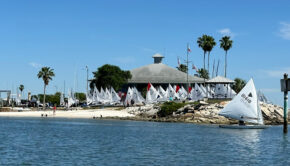
Sunfish championship week in Tampa →
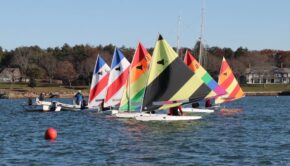
Intergalactic Rocket Challenge to the Editor →
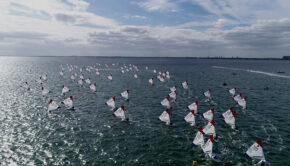
Peru wins 2023 Sunfish World Champs →
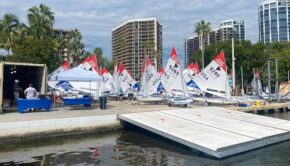
52nd Sunfish Worlds in the USA →
© 2024 Scuttlebutt Sailing News. Inbox Communications, Inc. All Rights Reserved. made by VSSL Agency .
- Privacy Statement
- Advertise With Us
Get Your Sailing News Fix!
Your download by email.
- Your Name...
- Your Email... *
- Name This field is for validation purposes and should be left unchanged.


Learn How To Sail A Sunfish Like a Pro: Essential Tips and Techniques
Alex Morgan
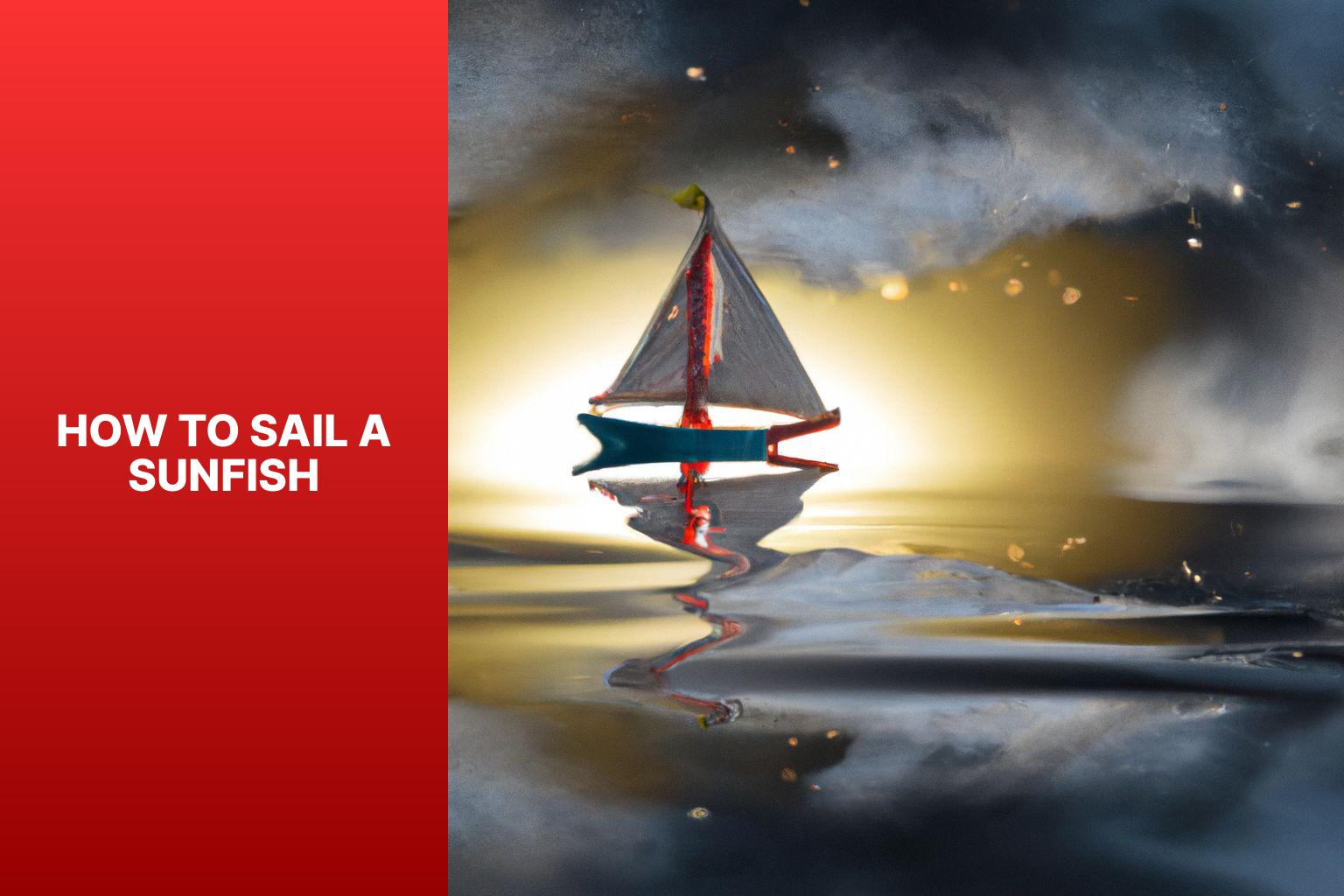
Sailing a Sunfish sailboat can be an exhilarating and rewarding experience for water enthusiasts. Whether you’re a beginner or a seasoned sailor, mastering the art of sailing a Sunfish requires knowledge, practice, and a little bit of adventure. In this comprehensive guide, we will take you through the essential steps and techniques involved in sailing a Sunfish.
The Sunfish sailboat is a popular recreational single-handed dinghy known for its simplicity, maneuverability, and versatility. Before getting on the water, it is crucial to understand the key features of the Sunfish sailboat, such as its design, hull construction, and rigging components.
To ensure a safe and enjoyable sailing experience, proper preparation is essential. This includes checking the equipment and safety gear to ensure they are in good condition and preparing the Sunfish sailboat by inspecting the hull, mast, sail, and rudder.
Mastering the basic sailing techniques is the foundation of sailing a Sunfish. This involves rigging the sailboat, understanding wind direction, adjusting sail trim, and effectively steering and controlling the rudder.
For those looking to take their sailing skills to the next level, advanced techniques such as sail positioning and shaping, tacking and jibing, and harnessing the power of the wind will be explored. These skills allow for greater control, speed, and maneuverability while sailing.
Safety should always be a top priority when sailing. We will provide important safety tips and precautions to ensure your well-being on the water, including proper use of personal flotation devices and understanding weather conditions.
We will discuss common mistakes to avoid while sailing a Sunfish, such as improper weight distribution, overestimating wind conditions, and neglecting maintenance and equipment checks.
By following this comprehensive guide, both novice and experienced sailors can enhance their Sunfish sailing skills, gain confidence on the water, and enjoy the thrill of sailing a Sunfish to the fullest. So, get ready to set sail and embark on an exciting journey with your Sunfish sailboat.
Key takeaway:
- Understanding the Sunfish Sailboat: Familiarize yourself with the key features of a Sunfish sailboat to ensure a safe and enjoyable sailing experience.
- Master the basics: Learn how to properly rig the Sunfish sailboat, understand wind direction and sail trim, and control the rudder for basic sailing techniques.
- Advance your skills: Explore sail positioning and shaping, practice tacking and jibing, and harness the power of the wind to enhance your sailing abilities.
Understanding the Sunfish Sailboat
Get ready to embark on an exciting journey into the world of sunfish sailboats ! In this section, we’ll dive deep into understanding the ins and outs of these magnificent vessels. From exploring the key features that make the sunfish sailboat a true marvel, to discovering the secrets of its exceptional performance, we’ll uncover everything you need to know to become a knowledgeable sailor. So buckle up and get ready to set sail with us!
Key Features of a Sunfish Sailboat
The hull of a Sunfish sailboat is fiberglass, making it lightweight and easy to maneuver. It has a triangular lateen sail that can be easily raised and lowered. The mast is aluminum, providing durability and stability. A daggerboard is used for lateral resistance and can be easily raised or lowered to adjust direction. The cockpit is spacious enough for one or two people to sit or move around comfortably. It has a simple rigging system, allowing for quick and easy setup and takedown. The Sunfish sailboat has a self-bailing cockpit, meaning water automatically drains out for enhanced safety. It has a kick-up rudder, which can be lifted out of the water to avoid obstacles or shallow areas. Known for stability and ease of handling, the Sunfish sailboat is suitable for beginners and experienced sailors. It can be easily transported on top of a car or trailer, making it convenient for sailing in different locations.
The Sunfish sailboat was introduced in 1952 by Alex Bryan and Cortlandt Heyniger . They aimed to create a small, affordable, and versatile sailboat for recreational sailing. The design quickly gained popularity, and millions have been sold worldwide since then. Its accessibility, simplicity, and reliability have made it a favorite choice for beginners and seasoned sailors. Over the years, the Sunfish sailboat has undergone minor design modifications but has remained true to its principles of stability, easy handling, and fun on the water. Today, it continues to be a beloved sailboat for individuals and families looking to enjoy the thrill of sailing in a compact and budget-friendly vessel.
Preparing for Sailing
Want to set sail on a Sunfish ? In this section, we’ll cover all the essential steps to get you ready for a smooth sailing experience. From checking your equipment and safety gear to preparing the Sunfish sailboat , we’ve got you covered. So, grab your sunscreen and let’s dive into the preparations that will ensure a fantastic time out on the water!
Checking Equipment and Safety Gear
Checking Equipment and Safety Gear is essential before setting sail on a Sunfish sailboat. Here is a comprehensive list of steps to follow:
1. Inspect life jackets: Ensure enough life jackets onboard for each person in good condition with no tears or damages.
2. Check safety lines: Verify securely attached and in good working condition.
3. Examine anchor and rope: Make sure anchor securely fastened and rope in good condition, free from fraying or knots.
4. Test horn or whistle: Ensure functioning properly and can produce a loud sound to signal for help if needed.
5. Inspect first aid kit: Check fully stocked with essential items such as bandages, antiseptic wipes, and pain relievers.
6. Verify presence of fire extinguisher: Confirm readily available on the boat and within expiry date.
7. Check communication devices: Test VHF radio or other communication devices onboard to ensure proper working order.
8. Ensure navigation lights are functional: Confirm working correctly, especially if planning to sail at night.
9. Check for any leaks: Inspect boat’s hull for any leaks or damages that could affect buoyancy.
10. Examine rigging and sails: Inspect for signs of wear, tear, or damage. Replace or repair as necessary.
True story: Once, while preparing to sail on a Sunfish, a sailor discovered a tear in their life jacket during the equipment check. Thanks to their thorough inspection, they promptly replaced the damaged life jacket and ensured everyone’s safety on the water. Remember, checking equipment and safety gear is crucial for a safe and enjoyable sailing experience.
Preparing the Sunfish Sailboat
To prepare the Sunfish sailboat, follow these steps:
1. Inspect the hull for damage or cracks. Repair or replace damaged parts.
2. Check the mast and boom for wear or damage. Ensure they are securely attached.
3. Attach the main sail to the halyard and raise it up the mast. Properly tension the sail.
4. Attach the boom to the mast and secure the mainsail to the boom using sail ties.
5. Check the daggerboard and rudder to ensure they are securely in place.
6. Attach the rudder to the stern of the boat and ensure it moves freely.
7. Inspect the lines and rigging to ensure they are in good condition and properly rigged.
8. Check the bailer and mast flotation to ensure they are functioning properly.
9. Attach any necessary safety equipment, such as a life jacket or whistle.
10. Double-check that all equipment is secure and properly fastened.
The Sunfish sailboat , known for its simplicity, affordability, and ease of use, can be prepared by following these steps. It was designed by Alcort, Inc. in the United States during the early 1950s and has gained popularity ever since. The design of the Sunfish sailboat has remained largely unchanged, with minor modifications made for better performance. It is a popular choice among sailors of all skill levels due to its lightweight design and stable hull, which make it suitable for racing, recreational sailing, and teaching sailing techniques. With its timeless design and versatility on the water, the Sunfish is a beloved classic in the world of sailboats.
Basic Sailing Techniques
Mastering the art of sailing a Sunfish requires a deep understanding of basic sailing techniques. From rigging the Sunfish sailboat to navigating wind direction and sail trim, and even mastering the art of steering and controlling the rudder , each sub-section in this voyage of discovery will unlock the essential skills needed to glide smoothly across the water. So grab your lifejacket and let’s embark on this thrilling adventure of Sunfish sailing mastery .
Rigging the Sunfish Sailboat
Rigging the Sunfish Sailboat is necessary before sailing. Follow these steps:
- Attach the mast to the mast step at the front of the Sunfish sailboat.
- Secure the sail to the halyard and hoist it up the mast, ensuring proper attachment.
- Connect the boom to the gooseneck at the bottom of the mast.
- Attach the mainsheet to the rear of the boom and thread it through the blocks on the Sunfish.
- Connect the mainsheet to the traveler, a sliding bar at the back of the boat.
- Attach the rudder to the back of the Sunfish, making sure it is securely in place.
- Check all the lines and rigging to ensure proper tightening and securing.
Once the Sunfish sailboat is rigged, you can start your sailing adventure. Always double-check your rigging before going on the water and familiarize yourself with the boat’s operation. Remember that weather conditions can impact sailing, so adjust the sail trim accordingly. Happy sailing!
Understanding Wind Direction and Sail Trim
Understanding wind direction and sail trim is crucial for successful sailing of a Sunfish sailboat. Adjusting the sail trim based on wind direction is key to optimizing the boat’s performance.
To determine wind direction, look for visual cues such as flags, water ripples, or movement of tree branches. It’s important to remember that wind can change direction, so regularly assess its angle relative to your boat.
Once wind direction is identified, adjust the sail trim accordingly. For effective upwind sailing, tightly trim the sail to catch more wind, creating lift and propelling the boat forward. Conversely, when sailing downwind, ease the sail to maximize the catching area and take advantage of the force of the wind pushing from behind.
Sail trim requires continuous monitoring and adjustment as the wind changes. Experimenting with different trim settings will help you find the optimal balance between speed and control .
Understanding wind direction and sail trim improves with practice and experience. Sailing and observing wind behavior will enhance your ability to instinctively trim the sail and enjoy a smooth and exhilarating sailing experience.
Steering and Controlling the Rudder
- 1. Check rudder position: Before steering the Sunfish sailboat, ensure that the rudder is centered, aligned with the boat’s keel, and straight.
- 2. Hold tiller extension: Firmly grasp the tiller extension, a long handle connected to the rudder. Maintain a comfortable grip while allowing for movement and flexibility.
- 3. Understand tiller and rudder relationship: The tiller is connected to the rudder, and any tiller movement directly affects the rudder’s position. Moving the tiller to the right turns the rudder right, and moving the tiller to the left turns the rudder left.
- 4. Adjust rudder angle: To steer the Sunfish sailboat, adjust the rudder angle. Push the tiller extension to the left to turn right, and push it to the right to turn left.
- 5. Maintain balance and stability: When steering and controlling the rudder, maintain balance and stability on the sailboat. Distribute weight evenly, stay centered in the boat, and make subtle adjustments for control.
Practice steering and controlling the rudder in different weather conditions and sailboat speeds to enhance proficiency. Through practice, you will develop a better understanding of effectively maneuvering the Sunfish sailboat.
Advanced Sailing Skills
Mastering the art of sailing a Sunfish requires more than just the basics. In this section, we’ll dive into advanced sailing skills that will take your Sunfish adventures to the next level. Discover the secrets of effective sail positioning and shaping , the art of tacking and jibing with finesse, and how to truly harness the power of the wind . Get ready to elevate your sailing game and navigate the waters with confidence.
Sail Positioning and Shaping
When sailing a Sunfish, proper sail positioning and shaping are key to efficient sailing. Consider the following factors:
– Wind direction: Position the sail perpendicular to the wind for maximum power.
– Sail shape: Adjust the sail’s shape using the cunningham, outhaul, and boomvang control lines.
– Cunningham: Tighten the cunningham to flatten the sail and reduce draft, especially in strong winds or for better upwind performance.
– Outhaul: Adjust the outhaul to control tension on the foot of the sail. Tightening it flattens the sail for increased speed and control in stronger winds.
– Boomvang: Properly adjust the boomvang to control tension on the leech of the sail and achieve optimal sail shape and control.
– Weight distribution: Positioning your body weight correctly on the boat is crucial for stability and performance. Adjust your position to maintain control and balance.
– Foot position: Properly position your feet on the hiking straps to balance and stabilize the boat. This allows for necessary sail adjustments and effective boat control.
– Continuously observe the sail and make necessary adjustments to adapt to changing wind conditions and optimize performance.
Mastering sail positioning and shaping in Sunfish sailing can greatly enhance your sailing experience and improve overall performance on the water.
Tacking and Jibing
– Prepare the Sunfish sailboat for tacking or jibing by trimming the sail and maintaining a steady speed. Begin the maneuver by turning the bow of the boat into the wind and crossing to the other side. Release the sail as the boat turns to make the turn smoother. Change sides on the boat to balance the weight and aid in the turn. Quickly switch the sail to the new side as the boat completes the turn and the wind fills the sail. Pull in the sail and adjust the trim for the desired speed and direction.
For jibing , turn the stern of the boat through the wind to change the direction. Prepare to release the sail as the boat turns and let it swing across. Cross over to the opposite side of the boat for balance during the turn. Guide the sail smoothly to the new side and adjust the trim accordingly. Continuously monitor the wind and make minor adjustments to maintain control and maximize efficiency.
Harnessing the Power of the Wind
Harnessing the Power of the Wind is crucial for successful Sunfish sailing. Here are some key points to consider:
1. Positioning the sail: Properly position the sail to catch the wind and propel the boat forward. Adjust the sail based on the wind direction and intensity.
2. Sail trim: Maintain proper sail trim to optimize wind capture. Adjust the sheet to keep it taut but not too tight. Watch for signs of luffing or flapping, which indicate insufficient use of wind power.
3. Using the telltales: Utilize the telltales on the sail to determine wind flow across its surface. The position and direction of the telltales help gauge proper sail trim. Adjust the sail to maximize wind efficiency.
4. Feathering: Reduce wind resistance and maintain forward momentum in strong winds by angling the sail away from the wind. This technique prevents excessive heeling and maintains control over the boat.
5. Understanding gusts and lulls: Be aware of changes in wind intensity. In gusts, loosen the sail to prevent overpowering. In lulls, adjust the sail to catch any available wind. Adapting to changing wind conditions improves overall sailing performance.
By implementing these techniques, you can effectively harness the power of the wind during your Sunfish sailing adventures. Practice and experience will improve your understanding of wind dynamics and enhance your sailing skills. Enjoy the exhilaration of harnessing nature’s force and explore the open water with confidence.
Safety Tips and Precautions
- Always prioritize safety when sailing a Sunfish by following these safety tips and precautions.
- Check the weather forecast before setting sail to ensure a safe and enjoyable experience.
- Before launching your Sunfish, inspect it for damages or leaks to prevent any potential accidents.
- To stay within the rules and regulations , familiarize yourself with the sailing rules of your location.
- Be mindful of your surroundings and keep an eye out for other boats or obstacles in the water to maintain a safe voyage.
- Keep a whistle or horn on board so you can easily signal for help in case of emergencies.
- Stay hydrated during your sailing trip by bringing enough water for your journey.
- Protect yourself from the sun’s harmful rays by wearing sunscreen and a hat.
Always prioritize safety when sailing a Sunfish and follow these precautions for a pleasant and secure sailing experience.
Common Mistakes to Avoid
- Not wearing a life jacket: Avoid not wearing a life jacket while sailing a Sunfish. Prioritize safety on the water and always wear a properly fitted life jacket to prevent accidents or drowning.
- Ignoring weather conditions: Avoid ignoring weather conditions. Check the weather forecast before sailing. Strong winds, storms, or other adverse conditions can make sailing difficult and dangerous.
- Overlooking proper rigging: Properly rigging the Sunfish is essential for a successful sail. Don’t overlook the rigging process. Ensure the mast, boom, and sail are correctly attached and tensioned for optimal sailing.
- Not understanding the centerboard: The centerboard plays a crucial role in maneuvering the Sunfish. Understand how to use it correctly for control and stability. Learn how to adjust it based on wind and water conditions.
- Forgetting to secure the mainsheet: The mainsheet controls the sail’s position and power. Avoid forgetting to secure it properly to prevent accidental jibes and loss of control.
Some Facts About How To Sail A Sunfish:
- ✅ The Sunfish is a small, one-person sailboat that has been popular for generations. (Source: Our Team)
- ✅ It is a personal-size, beach-launched sailing dinghy with a flat hull and a crab claw sail. (Source: Our Team)
- ✅ The Sunfish was developed by Alcort, Inc. in the 1950s and has since become the most popular fiberglass boat ever designed, with a quarter million sold worldwide. (Source: Our Team)
- ✅ Setting up a Sunfish takes less than 10 minutes and requires no special knowledge or fancy sailor’s knots. (Source: Our Team)
- ✅ There are resources available, such as YouTube videos and sailing classes, to help beginners learn to sail a Sunfish. (Source: Our Team)
Frequently Asked Questions
1. how long does it take to set up a sunfish sailboat.
Setting up a Sunfish takes less than 10 minutes and requires no special knowledge or fancy sailor’s knots.
2. Can a Sunfish sailboat be launched from anywhere?
Yes, a Sunfish sailboat can be launched from the beach, dock, or anywhere with water access.
3. Are there resources available to help beginners learn to sail a Sunfish?
Yes, there are resources available such as YouTube videos and sailing classes that can help beginners learn to sail a Sunfish.
4. What is the sail plan and hull of a sailboat?
The sail plan and hull of a sailboat create lift forces in 3 dimensions as they react to wind and water.
5. How can I achieve balance and control while sailing a Sunfish?
Balancing the forces of the sail and hull is key to maintaining control and speed. Experimentation and practice are necessary to find the best settings and achieve comfort and control while sailing.
6. What are some tips for adjusting the sail’s center of effort and improving control?
Lowering the sail on the mast can help reduce heeling and allow for better control through hiking. Adjusting the gooseneck on the boom can reduce weather helm and improve control. Other controls like the vang, outhaul, and cunningham can further tweak the sail’s center of effort and de-power the sail.
About the author
Leave a Reply Cancel reply
Your email address will not be published. Required fields are marked *
Save my name, email, and website in this browser for the next time I comment.
Latest posts

The history of sailing – from ancient times to modern adventures
History of Sailing Sailing is a time-honored tradition that has evolved over millennia, from its humble beginnings as a means of transportation to a beloved modern-day recreational activity. The history of sailing is a fascinating journey that spans cultures and centuries, rich in innovation and adventure. In this article, we’ll explore the remarkable evolution of…

Sailing Solo: Adventures and Challenges of Single-Handed Sailing
Solo Sailing Sailing has always been a pursuit of freedom, adventure, and self-discovery. While sailing with a crew is a fantastic experience, there’s a unique allure to sailing solo – just you, the wind, and the open sea. Single-handed sailing, as it’s often called, is a journey of self-reliance, resilience, and the ultimate test of…

Sustainable Sailing: Eco-Friendly Practices on the boat
Eco Friendly Sailing Sailing is an exhilarating and timeless way to explore the beauty of the open water, but it’s important to remember that our oceans and environment need our protection. Sustainable sailing, which involves eco-friendly practices and mindful decision-making, allows sailors to enjoy their adventures while minimizing their impact on the environment. In this…
The Sunfish: A Perfect Lake or Urban Sailboat
- Snowboarding
- Scuba Diving & Snorkeling
Hailed as "the most popular sailboat ever built," the Sunfish is still going strong after more than fifty years. Its popularity is partly due to its low price and easy portability, but it also sails well and is a lot of fun for both beginners and experienced sailors alike. This is a daysailer for active sailing, as it's mostly a single-handed boat. You're likely to get wet unless the water is flat and the wind is light, but for sheer fun and ease of sailing, the Sunfish is terrific. As long as you remember to move your body (the ballast) when you tack and gybe , you can't go wrong with a Sunfish.
The Pros and Cons
- Very easy to rig and sail with a single control line (mainsheet)
- Virtually the only car-top sailboat
- Fast planing sailboat in good wind
- Kick-up rudder and daggerboard allow easy beaching
- Widely available and inexpensive as a used sailboat
- Holds only one full-size adult (or an adult and child - or two teens)
- Tiny cockpit and little freeboard makes for wet sailing
- Not as much a racer as a Laser
- Easily capsized by a beginner
Description
- Length overall: 13 feet 9 inches
- Beam: 4 feet 1 inch
- Draft: daggerboard up: 6-8 inches - adjustable down to 35 inches
- Empty hull weight: 120 lbs.
- Sail area: 75 sq. ft.
- The cockpit is self-bailing with the boat moving
- The lateen sail automatically spills wind when a gust hits
- Races in International Sunfish Class
Replacement parts widely available at dealers and online
- MSRP $4220, or in good condition for a few hundred used
A Perfect Lake or Urban Sailboat
First sold as a wooden boat and do-it-yourself kit, the original fiberglass Sunfish introduced in 1960 has not changed much in the half-century since. Over 300,000 have been built by seven manufacturers over the years, a phenomenal number for any boat. The stable hard-chine hull design and lateen sail rig remain the same and are integral to the boat's success. The lateen sail, compared to the taller Bermuda rig used on most modern sailboats, keeps the force of the wind low and causes less heeling. Another advantage is when a gust strikes, the lateen rig's mechanics allow some wind to spill, reducing the risk of capsizing. While racers prefer never to sacrifice any wind, and consequently many have gone to a Laser or a Super Sunfish (same hull but a Bermuda rig), the traditional Sunfish with lateen sail remains popular and sails well downwind and in light air.
It Stands up Well
While there have been some variations among Sunfish built by the different manufacturers over the decades, the hull has remained rugged and stands up well to abuse. It's not surprising to find a twenty or thirty-year-old Sunfish still in good shape regardless of scratches and dings in the fiberglass. Neophytes are sometimes surprised by the boat's buoyancy and stability, given its thin body profile. With a hollow body and small cockpit, however, the Sunfish floats high and is unsinkable when capsized. With the daggerboard in place, it can be righted fairly easily after a capsize once you learn how .
Responsive to Direction and Wind Changes
A key advantage of the Sunfish, its portability, is a limitation for some. While two small adults or teens can sail together, this is not a boat for social conversation or a quiet, meditative picnic on the water. Rather, a Hunter 140 or similar daysailer is more comfortable for two or three crew. Since the boat is so responsive to direction and wind changes, and to steering changes and the position of body weight, you need to pay attention to what you're doing at all times.
Except when things are fairly calm, it's not a good idea to cleat down the main sheet, as you want to be able to quickly let the sail out in a strong gust. With one hand on the sheet and the other on the tiller, and ducking below the boom while shifting your weight side to side every tack and gybe, you're kept busy, but that also makes for a more intense sailing experience.
A Great Boat to Stow Away
Overall, this is a great boat to keep at a lake, stow away in your garage or car-top to a nearby bay for an afternoon's great fun. Once you've learned the basics of sailing , anyone can sail a Sunfish. When the wind is good, even the pros can have fun zipping about over the water. If you eventually feel you want a faster, more exciting boat of the same size, consider a Laser.
- How to Tack a Sailboat
- Choosing a Centerboard or Fixed Keel Sailboat
- How to Tow a Dinghy Behind a Sailboat
- Learn How to Sail a Small Sailboat – 1. The Parts of the Boat
- How to Rig a Preventer Line
- How to Heave To a Sailboat
- Choosing an Inboard or Outboard Engine
- Simple Reefing System for Sailors
- Best Sailing and Boating Apps
- Review of Lehr Propane Outboard Engine
- How to Anchor a Sailboat
- HGTV Dream Home Winners
- 2011 Honda CBR250R Review
- 2009 Johnny Pag Motorcycles Pro Street Review
- The Different Approaches to Catching and Fishing for Grouper
- Saltwater Fishing Tips for Freshwater Fishing Enthusiasts
Boat Profile
Super Sailfish
A wild and wet ride
From Issue August 2019
S eventy years ago, LIFE put the Alcort company on the map when the magazine featured the Sailfish sailboat in an article titled “ World’s Wettest, Sportiest Boat ,” published in the August 15, 1949 issue. Two years earlier, Alcort had expanded their market from iceboats to the little Sailfish, a lateen-rigged wooden hull that measured just under 12′. The boat was easy to handle, affordable, and offered a sporty, splashy ride to America’s post-war market of recreational sailors.
In 1946, Alex Bryan and Cortlandt Heyniger had combined bits of their first names to create Alcort, Inc., and the first sailboat that they designed, in 1947, was the 11′ 7″ Sailfish, built in Waterbury, Connecticut. The Sailfish had a beam of 31-1/2″, a crew capacity of 300 lbs, and weighed 82 lbs. The volume of air enclosed by the hull and deck made the boat virtually unsinkable. A 65-square-foot lateen sail provided ample power.
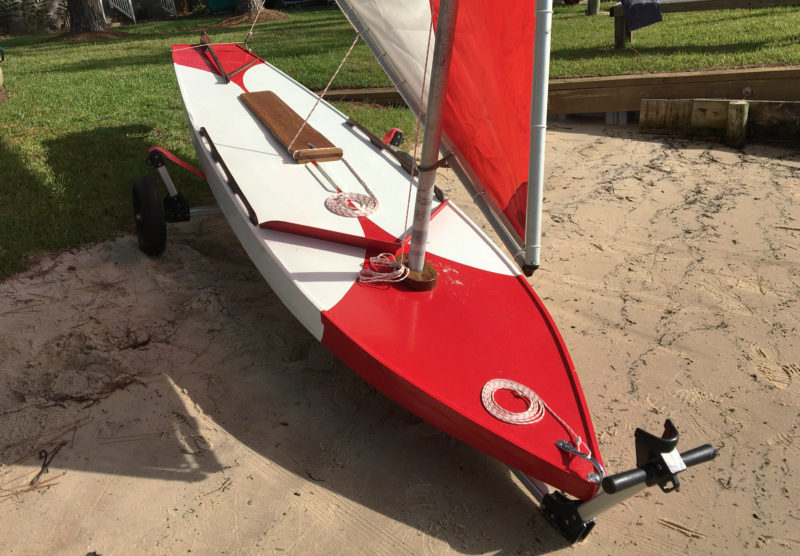
The authors’ Super Sailfish, ZSA ZSA, is their restoration of a wooden boat built in the 1950s. Here, the varnished daggerboard rests just aft of its slot.
The boat gained immediate popularity after the LIFE article, and within a few years the original design was lengthened to 13′ 7″ and widened a bit to 35-1/2″. The larger Sailfish flew a 75-square-foot sail, weighed 102 lbs, and had a crew capacity of 400 lbs. The original Sailfish was then labeled the Standard Sailfish and the big sister named the Super Sailfish. Production of the two models of Sailfish was brisk, and in 1960 Alcort added a fiberglass version, the Super Sailfish MK II. The MK II hull was the same size as the Super Sailfish, had the same capacity of 400 lbs, and used the same rig, but weighed 98 lbs. Alcort was also producing the wooden Sunfish, which used the same sail rig, daggerboard, and rudder as the Super Sailfish line, and a fiberglass Sunfish with a longer daggerboard and taller transom.
The Alcort literature promised the Sailfish would deliver “thrilling speed, brilliant performance, perfect portability, and swamp-proof safety.” The hull, deck, and frames were made of marine plywood, with mahogany sides, transom, rudder, tiller, and daggerboard. Wilcox and Crittenden in nearby Middletown manufactured the bronze and brass fittings for all of the Alcort boats. The spars on the original Sailfish were cut from Sitka spruce, mid-generation masts were a hybrid aluminum base with wooden top, and spars from the late 1950s on were aluminum.
Alcort offered the Standard Sailfish, Super Sailfish, and Super Sailfish MK II as factory-built boats, and they sold precision-cut knockdown kits for a wooden Sailfish through the late ’50s through the mid-’60s. The Standard Sailfish was phased out in the mid-’60s and the Super Sailfish kit was last seen in the late ’60s. Along the way, a two-page set of plans was produced by Alcort with measurements and a materials list for the frames, hull, rudder, daggerboard, spars, and sail. Armed with the plans, an intrepid home builder could build the boat with locally sourced lumber and hardware. We had occasion recently to replace the bottom panels on a factory-built Super Sailfish, and while we had the panels off we validated the measurements in the plans, and all were within a 1/32″ with only one exception. The factory boat’s bow was swept up just under 1″, a design improvement that helped reduce submarining.
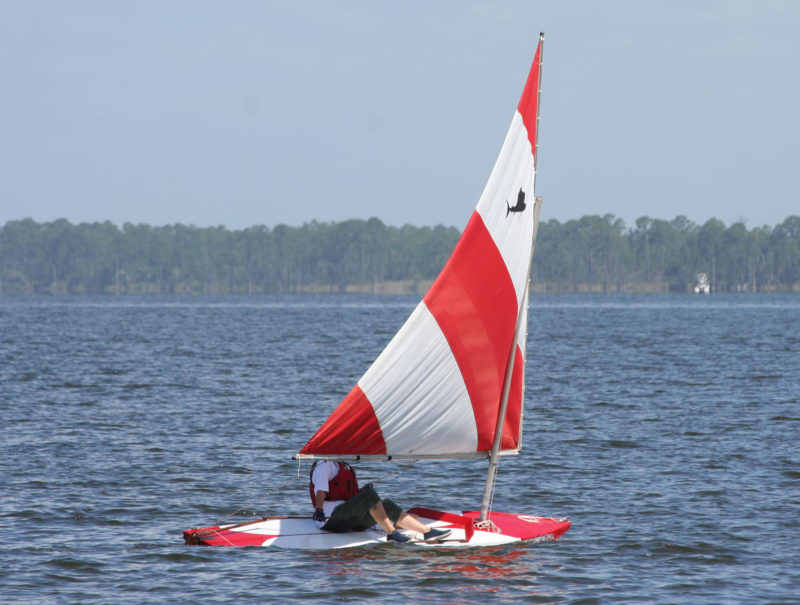
The handrails amidships have an important role as foot bracing to keep the sailor from sliding off the deck when the boat heels.
T he Sailfish kits came with all of the wood, hardware, sails, and line needed. Finishing kits with primer, putty, paint, and varnish could be purchased as well. Alcort provided eight pages of well-written instructions with 16 photos. The first two pages of the instructions contained a list of parts included in the kit with numbered photos. The hull was assembled upside down using the shipping crate as a strongback. The first step was to attach the 13′ 3-3/4″ deck longeron to the stem, the seven frames, maststep, daggerboard trunk, and transom. The parts were coated with a sealer, and then screwed together, and the deck was then temporarily attached to the skeleton frame and the solid-wood sides were screwed on, attached first to the stem and pulled into place on the transom with a rope windlass. The inner keel longeron was attached to the frames, and it and the sides were beveled to accept the plywood bottom panels. They were attached with glue and bronze ring-shank nails.
The assembly process was easy. Alcort advertised that it could be done over a weekend with a hammer, rasp, plane, screwdriver, handsaw, square, brace, drill, and bits. A jigsaw would be helpful for building a hull from plans.
The Sailfish delivers on Alcort’s promise of fun. We have sailed all of the models and have only capsized once when a sail caught a puff and the sheet pulled Skipper off the deck. The sheet had no fairlead or cleat, so it was either let go of the sheet or go for a short swim. One sailor joked that “the Sailfish was the boat that you learned to swim on.” The shallow-V hulls of the Super Sailfish and especially the Standard Sailfish with its 31-1/2″ beam, require more balance than the Sunfish. When sailing Sailfish, we tend to sit more amidships and hike out by laying backward at an angle, rather than perpendicular to the centerline. Handrails on the deck serve as foot braces to help maintain control of the boat while hands are busy with the sheet and tiller. Some of the models had a small toerail, which is also helpful for maintaining a grip on the flat, cockpitless deck. The sheet also works as a tether to help keep skippers aboard. Some of the Sailfish had nonskid on the deck, but it quickly wore out pants bottoms. One trick that we’ve come up for tacking is to lean backward instead of forward—while you’re wearing a PFD it is harder to bend forward on a Sailfish than on a Sunfish, which has a cockpit to tuck your legs and feet into.
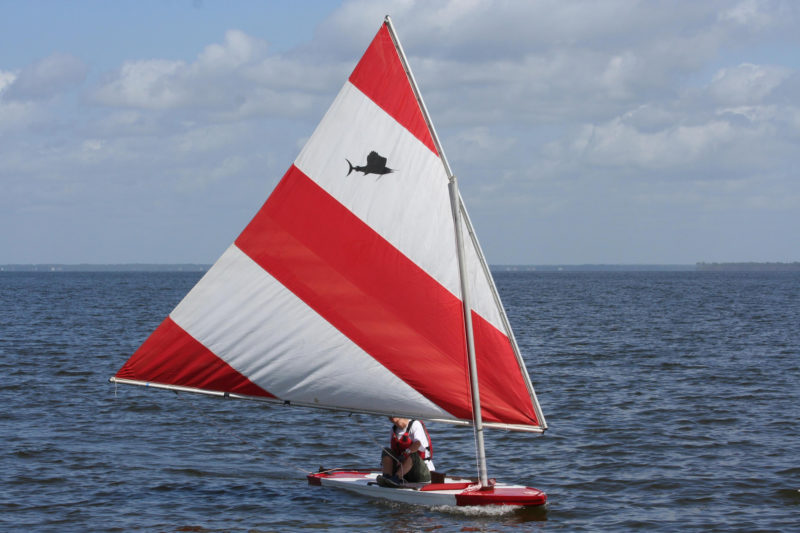
The most recent versions of the spars and mast for the Sailfish were all aluminum.
The Sailfish 65-square-foot sail for the Standard and 75 for the Super are appropriately sized, neither too small to provide fun, even exciting sailing, nor so large as to be overpowering and leading to frequent capsizes. All of the models power up quickly. We’ve found that tacking is improved with a longer daggerboard, similar to the one found on the 1960s fiberglass Sunfish. The mast is easy to step and even kids as young as eight can raise the sail. Our Sailfish moves well even in the lightest of breeze; we enjoy the fingertip control on the tiller and setting coffee cups set on deck, without them sliding over the side. Once the breeze picks up to 5–8 knots, a little more activity is needed to balance the boat and get through tacks smoothly. At 10–12 knots we are moving quickly to stay on course and work the puffs, and above 12 knots we have sailed the Super Sailfish with two on board, one at the tiller and the other serving as movable ballast.
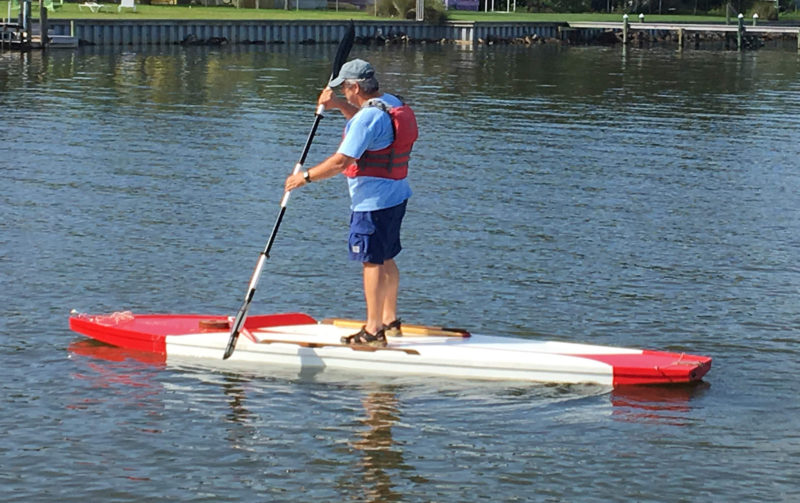
With the sailing rig left ashore, or even stowed on deck, the Super Sunfish serves nicely as a stand-up paddle board.
A lcort made a lot of promises with the Sailfish and delivered on all of them. We’ve even come up with a few more uses for the boats. The Sailfish, with its deck unbroken by a cockpit, makes a respectable stand-up paddleboard, and with a 400-lb capacity, it is well suited for larger paddlers or for an adult taking little crew members out paddling. The deeper hull design has a greater capacity than a normal paddleboard and makes for a very stable platform. The small keel strip helps the boat track straight under paddle power. We can paddle our MK II out in flat calm, and set sail if the wind picks up. I took the hull out once with a low-slung beach chair lashed to the handrails, and it made a fine sit-on-top kayak, a very useful fishing platform or picnic boat. We have also seen folks add outriggers and take their pets out for a ride with plenty of room for the whole pack.
Kent and Audrey Lewis blog about and maintain a fleet of vintage Alcorts that include a Standard Sailfish , Super Sailfish , Catfish and a wooden Sunfish, along with several fiberglass Sunfish. They also maintain the Yahoo group Sunfish Sailor and publish The Sunfish Owners Manual .
Sailfish Particulars
Length/11′ 7″
Weight/82 lbs
Capacity/300 lbs
Sail Area/65 sq. ft.
Super Sailfish Particulars
Length/ 13′ 7″
Weight/102 lbs
Capacity/400 lbs
Sail Area/75 sq. ft.
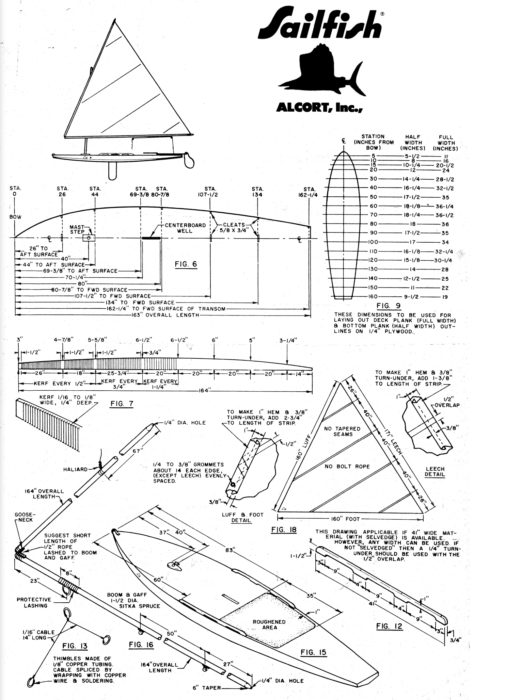
Super Sailfish with offsets
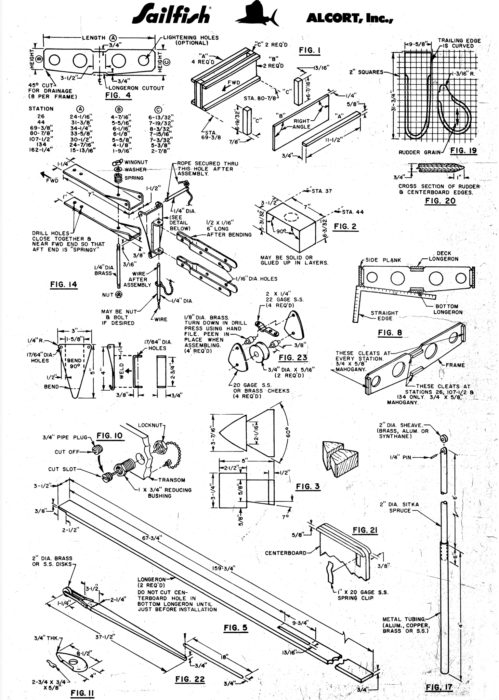
Super Sailfish parts
The kit assembly instructions can be found in the Files section of the Sunfish Sailor Yahoo group (after joining the group) and are very helpful when repairing wooden Sailfish, or for building a new Sailfish from the plans, found in the same Files. Sunfish sails and spars to fit the Super Sailfish can be ordered from Sunfish Direct . The Sunfish is manufactured in fiberglass by Laser Performance .
Is there a boat you’d like to know more about? Have you built one that you think other Small Boats Magazine readers would enjoy? Please email us!
Share this article
Join The Conversation
We welcome your comments about this article. If you’d like to include a photo or a video with your comment, please email the file or link.
Comments (15)
Let’s build one FOUR times original size! What a hoot! May have to reduce sail area proportionally….just imagine the fun! Or take one to J boat size! Wow!
Great article. Love the video to see how it sailed. But most of all, really enjoyed reading the history behind the ubiquitous Sunfish, which I have sailed often over the years. The wooden Sailfish versions were before my time. Thank you.
We have a mini sunfish that we bought used in the 1980’s. It is a sturdy craft, and we have sailed it a lot over the years down here in the Florida Panhandle. I repainted it with Interlux fifteen years ago, and it still looks good. It seems to be indestructible. I am thinking of making a longer dagger board for her, after reading the excellent article in Small Boats . Anybody know where I can get a new handle?
It’s interesting how things come around.
Al and Cort first built the Sailfish as a paddleboard to go after swimmers as they were trying for a Red Cross contract. An enlarged surfboard if you will. Too expensive for the Red Cross. So what to do with it. Besides iceboats, Al and Cort were open canoe sailors, and presumably had some kit kicking around. Doesn’t take much to put the two together. The LIFE article came about by some kind of friend-of-a-friend-girlfriend relationship. Don’t remember the details. In today’s saturated world it is difficult to think of a media splash that would have the same impact as a multiple page spread in LIFE . Not so incidentally Al and Cort created the first fully self-rescuable sailing craft.
The Sunfish apparently happened when either Al’s or Cort’s wife became pregnant and found the Sailfish hard to sail.
And it is interesting to see that the Sailfish does work pretty well as a paddleboard!
I got mine as a 13th-birthday present from my grandmother, back in 1967, and sailed her on Cranberry Lake in NW New Jersey. My evil trick was to grab a gust, haul in, then climb over the side to stand on the daggerboard, dumping my crew in the middle of the lake. I could right her and be off again before they knew what was happening.
Nice useful information here. I just purchased an early ’70s MK II. Ready to start cleaning it up. Question: there is a small (3/8″ – 1/2″) hole located next to the bow handle on the deck. Any idea what it’s for? A drain of some type maybe? Any help would be appreciated.
The Alcort Sailfish and Sunfish featured in your current issue are wonderful boats! The underlying philosophy of fun, simplicity and low cost, coupled with ease of transport and storage, would have given access to sailing to many, many people who otherwise would never have had an experience of the sport.
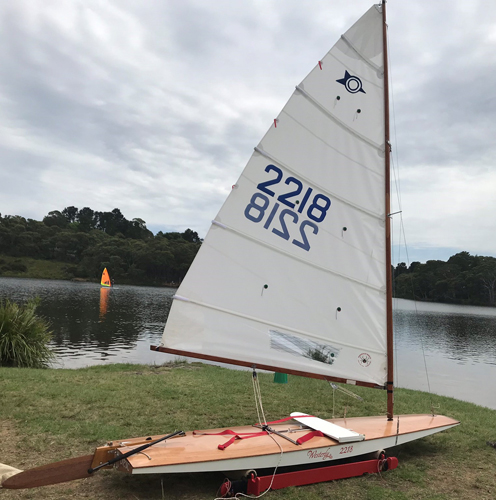
The Australian Sailfish very quickly became popular at clubs on Port Phillip, and then spread rapidly through the eastern states of Australia and onto Papua New Guinea. An Australian Sailfish Class Owners Association was formed in 1961. National championships commenced in 1968 and were held annually thereafter.
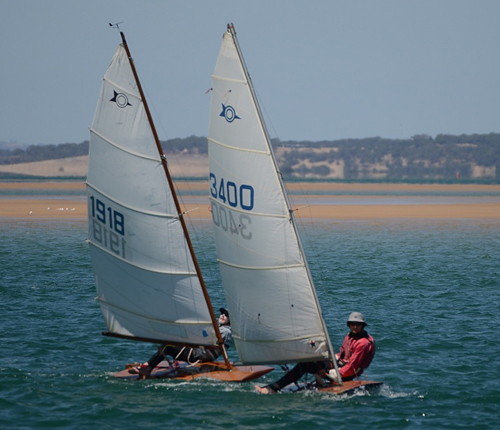
Pleasingly however, there has been a wooden-boat renaissance in Australia over the past decade or so, and this has lead to a revival also of the Australian Sailfish. There have been fleets of ten to twenty Sailfish participating at wooden-boat regattas over the past few Australian summers. There have been new builds, plans have been distributed worldwide, and there have been three Australian Sailfish built in the past year in the USA in Florida, Wisconsin, and San Francisco. This revival has been promoted and reflected by an Australian Sailfish website, of which I am a co-administrator. Jack Carroll remains well and active at 90 years of age, and was in fact awarded with an Order of Australia in June this year for services to sailing.
In June this year, I was fortunate to attend the WoodenBoat Show at Mystic Seaport, something I’ve wanted to do for many years. While there, I visited the museum’s small-boat collection. I was on a mission. Just inside the entrance was the Alcort Sunfish, racked up with its stablemate, the Laser. I went exploring further, and, to my delight, I found the Alcort Sailfish tucked away in a back corner of the collection. It was a thrill.
Several days later, by chance, I was able to hire a Sunfish on the beach at Chatham on Cape Cod, and sail it on the waters of Nantucket Sound. That was a great thrill!
I hope that this information might be of some interest to you. Thank you for your wonderful magazine.
Would anyone like to buy an early model of the Super Sailfish that is in great shape?
In the late ’50s and early ’60s we would sail with a neighbor on his Sunfish in Lake Michigan. Usually, sailing was a lot of fun, except for the day when small-craft warnings were posted, and we capsized, breaking the aluminum mast against the sand.
Great article.
I had a Sailfish and sailed Lake Ontario and some northern Ontario lakes with it from 1975 to 1991. It was faster and more athletic to sail than the Sunfish that we also had. I wish they were still available.
We rented a Sunfish 1966 and sailed it on Lake Simcoe near Big Bay Point. I convinced our family to buy one the next year. Sailed it at our rented cottage on Lake Simcoe and Lake Ontario from the Silver Birch Boathouse in east-end Toronto beaches for the next 9 years. Then was invited to race International 14 and Thunderbird yachts because of my Sunfish experience. Now I’m back in Sunfish racing in Canandaigua Lake and Rochester. Love going out in my Sunfish when the wind is too much for other boats.
A couple of answers.
1. For a replacement Minifish daggerboard I’d watch eBay for a “Barrington” board. If the desire is to make new handles, cut some 3/4″-square cleats and screw them to the top of the new, longer daggerboard.
2. The hole up by the bow handle was for a drain plug.
My first boat was a Masonite Sailfish (1974). The drain plug was in the transom, and it had wooden spars, grab rails, mast step, etc., and an old cotton sail. I varnished all the wood, and painted her international orange with a white cockpit – don’t laugh, it looked great with the varnished accents! The first time I capsized her, I was petrified, but then my feet hit the bottom! Shallow water! One time she just refused to tack, and when I got her home, found out that the stern drain plug had not been screwed in, and she weighed about 500 pounds. Many other newbie stories with that boat. Great fun always.
If you guys wanted to go back in time, my grandfather co-invented the Sunfish. Here is a poem I wrote about it:
A Maple leaf floated on the lake Momentum pushed it into a breeze Cortlandt watched it slowly drift by, tacking south The wheels in his head started turning Shorter, he thought, if the boat is shorter, it will turn more sharply It will be an easier boat for play In time, it was, and they were sold worldwide But for now, Bud tried to manipulate a sheet of paper into an airplane He wanted to see if he could hit the leaf Nailed it
Murray Dunlap “Next to a brain injury, the devil is a clawless kitten.”
Leave a Reply Cancel reply
Your email address will not be published. Required fields are marked *
Stay On Course
More From This Issue

From The Editor
Anchored in Jeopardy
I’ve had only four anchorages go wrong (so far). In the middle of a night aboard my dory skiff, I had to sit up in my sleeping bag and row…

Oxford Wherry
Despite the author's budding workmanship and a few errors, he finished the project with a beautiful, shapely hull sitting in his garage. He says the building process was very satisfying…

In 1946, Alex Bryan and Cortlandt Heyniger had combined bits of their first names to create Alcort, Inc., and the first sailboat that they designed, in 1947, was the 11’7”…
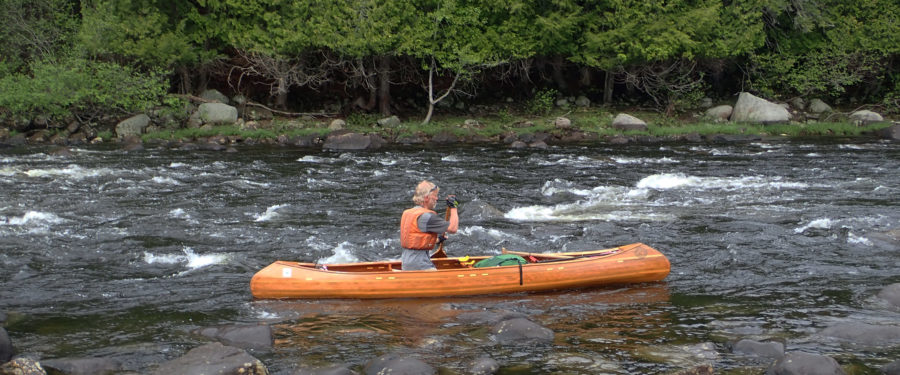
An Uphill Battle
I had first paddled the trail five years previously, a solo trek of over 750 miles in twenty-eight days, in a 14-foot cedar-strip canoe that I designed and built. To…
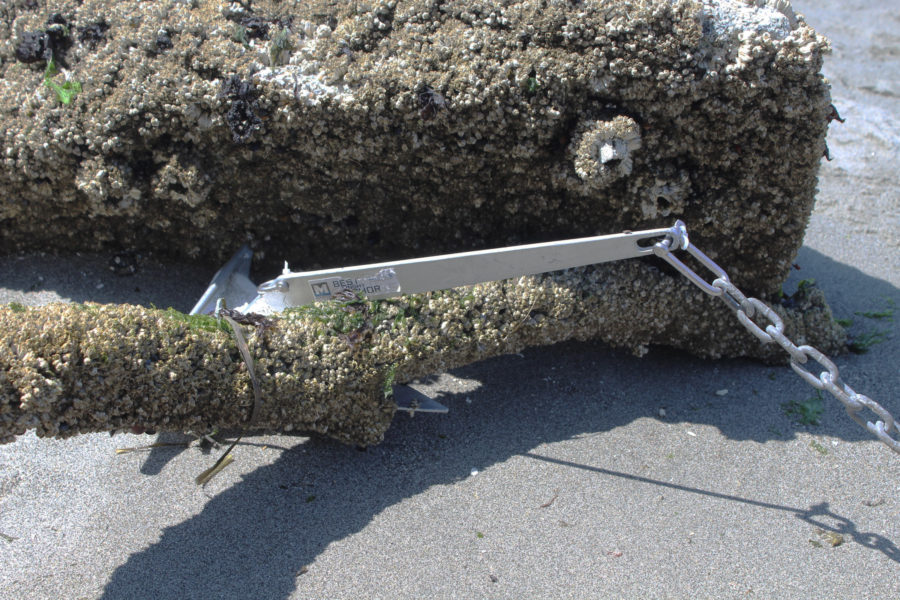
Anchors Astray
should have known better. The slough where I dropped anchor for the night was among the many tidal backwaters of the Snohomish River near Everett, Washington. The sloughs were littered...
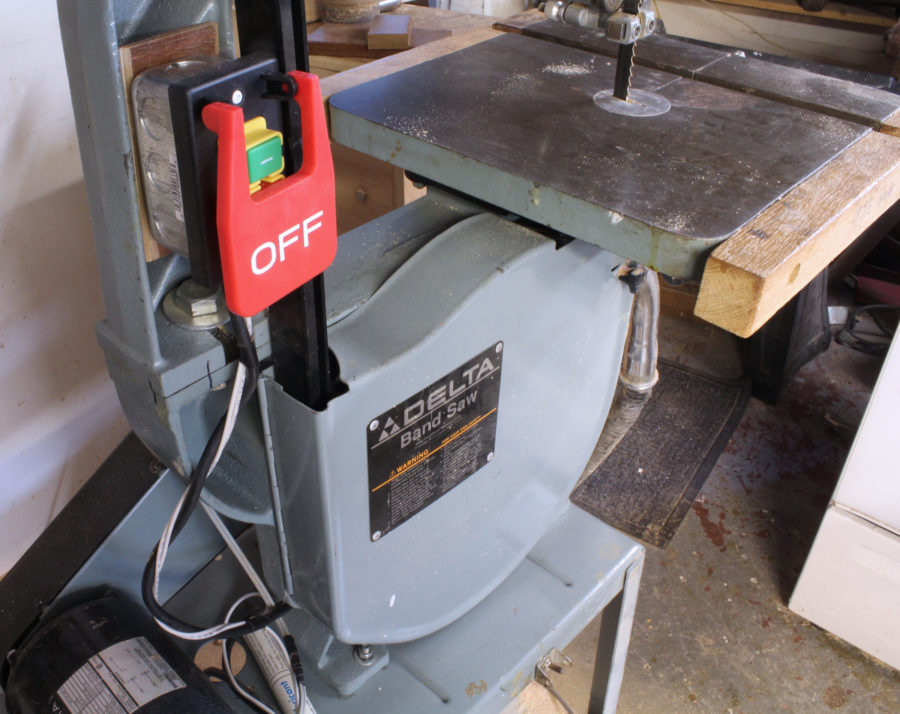
Product Reviews
Pedal and Paddle Switches
I often have an awkward and anxious moment when I’ve finished a cut on my table saw or bandsaw and have to reach down to turn the machine off while…
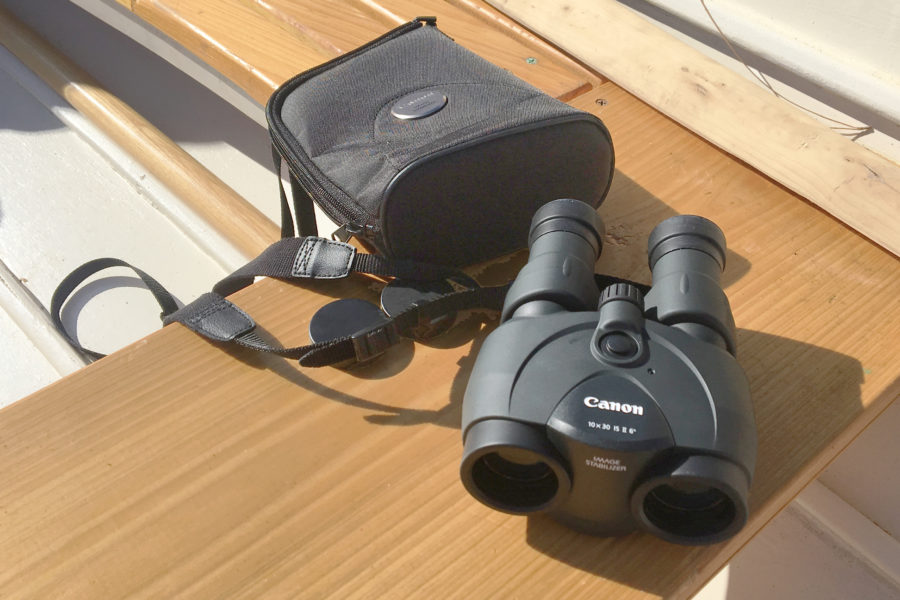
Image-Stabilized Binoculars
The Canon binoculars are very compact and lightweight. They measure 5.9” by 5” by 2.8” and weigh 1.33 lbs. Two AA batteries power the image-stabilization function, and last for up…
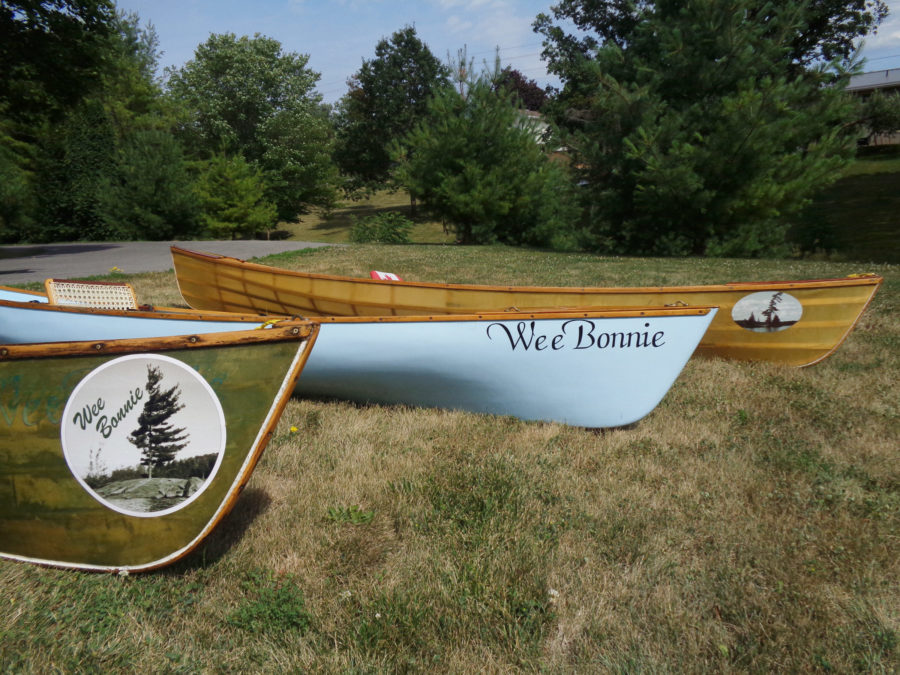
Reader Built Boats
Phil Boyer started work on a cedar-strip Wee Lassie II in 2005 and only got as far as setting up the molds when he discovered that canoes could be built…
More Boat Profile

Duck Trap Wherry
Rowing the wherries is a sheer pleasure. The fine ends create very little drag. It is almost like rowing a competition skiff. I never felt like I was hitting the…
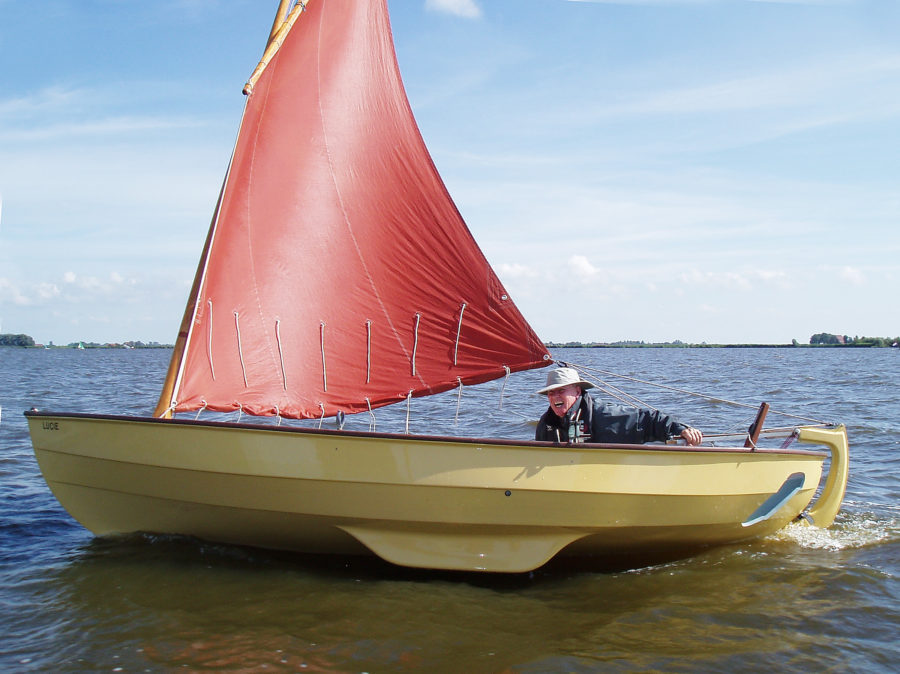
Devon Scaffie
The Scaffie was designed by John Watkinson, founder of the Drascombe line of small boats, and has been in production in the U.K. since 1978. It is 14′9″ long with…

One of the better-known trailerable boats in Southcentral Alaska is the Tolman skiff. Designed by the late Renn Tolman of Homer, Alaska, in the early 1990s, the three models of…
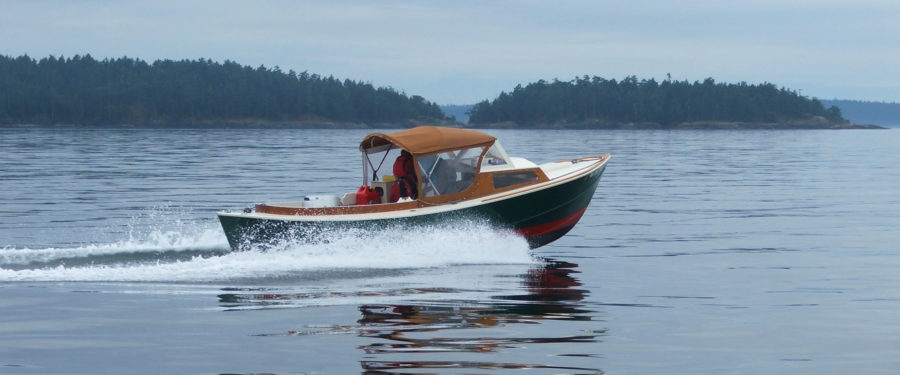
19′ Bartender
The Bartenders, in six models ranging from 19′ to 29′, were designed by George Calkins during the 1950s to negotiate the river bars along the Oregon coast. He died in…
Subscribe Today!
Become a subscriber today and you’ll recieve a new issue every month plus unlimited access to our full archive of backlogged issues.
Already a subscriber? Sign In
Subscribe For Full Access
Flipbooks are available to paid subscribers only. Subscribe now or log in for access.

Small Sailboat Sizes: A Complete Guide

Last Updated by
Daniel Wade
October 30, 2022
Key Takeaways
- Small sailboats are easy to sail, rig, and are affordable
- They are usually under 20 feet to be considered small
- Might not fit a particular sailing goal
There are plenty of small sailboat sizes to accommodate any sailing experience. But what kinds of small sailboats are there?
Small sailboats are generally under 20 feet in length, come in a variety of designs, and have different hulls. These include monohulls, catamarans, and trimarans. As long as they have a mast, rudder, sail, and are under 20 feet, it is considered a small sailboat.
According to experienced sailors that use a smaller boat, it is best to have one that is easy to handle and accommodates their sailing goals. When searching for the best small sailboat, it will likely differ from one person to the next.
Table of contents
23 Small Sailboats to Compare
When looking at different types of small sailboats, it is important to see how they are designed. Depending on the sailing goals a person has will ultimately affect how they intend to sail.
If I have a Hobie catamaran, I am likely going to use it for recreational purposes like coastal cruising instead of racing. For shallow drafts, I would need something that can handle entering that territory and not risk damaging a keel on some monohulls.

Marblehead Daysailer
The Marblehead 22 daysailer is a traditional looking monohull perfect for everything related to small sailboats. Even though it is compact, there is enough room for guests on board.
It has almost a 12 foot cockpit to seat several people, along with a stowaway cuddy in the front to put some gear into. With its bulb keel, however, I would not take it into shallow waters.
A Laser is a great small sailboat that is commonly raced. In fact, they have been used in the Olympics every year since 1996.
Laser’s have a tendency to capsize if mishandled by inexperienced sailors in rough conditions, but are good to learn how to sail. I would recommend taking them out on lighter days and calmer conditions.
Catalina Sport
The Catalina 22 Sport has earned the reputation for the best small sailboat for years. It has simple amenities for different sailing goals, but also has a retractable keel to allow for shoal draft exploration.
For a boat this size, it can sleep four people and has a swim ladder in the back. Sailors that are used to simple designs will be happy that it has a roller furling jib, a fractional rig, and a mainsail. For a boat that is under 25 feet, it is arguably the epitome of small sailboats.
Cape Cod Daysailer
The Daysailer by Cape Cod was a first of its kind back in the 1950’s. It could travel however a sailor saw fit, with capabilities of racing, cruising, or simple pleasure.
Roughly a thousand were built by various shipyards, but Cape Cod still continues to produce them. For a 16 foot sailboat, it packs a punch with an affordable price and enough room for a few people.
The BayRaider from Swallow Yachts is another great example of a small sailboat that is easy to navigate and to put on a trailer for transport. What I love about it is that just about all of the 20 feet of the boat is an open cockpit.
If I were consistently using it in rougher waters, I would recommend adding a spray hood to help keep sections of the boat dry. In addition, I would look for the option to add stability with 300 pounds of water ballast.
For those that enjoy a solo ride, the Beetle Cat is one to consider. This boat has a draft of two feet and is roughly 12 feet long, which makes it perfect for coastal cruising or much tighter spaces.
With its single gaff-rigged sail, it offers tons of power even with lighter air. It is also nice to use when the conditions become rough and it is easy to reef down.
West Wight Potter
The West Wight Potter has a particular model, the P19, that is on many sailors’ lists of great small sailboats. A lot of sailors prefer this boat due to a variety of features for its size.
At just under 20 feet, it has four berths, galley, sink, stove, and even a cooler. This boat also has closed-cell foam on the fore and aft, making it virtually unsinkable.
The Norseboat 17.5 is the perfect sailboat in mind when it comes to rowing and sailing. Whether it has one or two people, there is plenty of room to sail comfortably.
While it is not the best boat to probably have in rough conditions, I would likely use this to find coastal areas with good camping spots. With its excellent load capacity, there are plenty of opportunities to bring all kinds of gear without fear of weighing the boat down.
Even though the Montgomery 17 is advertised as a trailerable pocket cruiser, it packs a punch for a smaller sloop rig. It even comes with a centerboard keel that can be retracted to make the boat draft just two feet. This is great for those that want to cruise along the coast or beach it and go exploring.
The cuddy cabin has plenty of headroom and two bunks for guests. There are other models that Montgomery offers such as the 15 and 23, but the 17 is arguably the most attractive for tighter spaces navigating and the best bang for buck scenario.
The CW Hood 32 is somewhat misleading for a small sailboat since it is roughly 32 feet in length. However, sailors will only use about half of the boat in the cockpit with seating and navigating.
This boat is specifically designed for day sailing in mind, with nothing on board to distract anyone from sailing. It is a perfect sailboat for a family without being too large to handle.
The 17 foot and half Sun Cat from Com-Pac Yachts is a great looking small sailboat. With its gaff-rigged mainsail, it powers easily with light conditions.
It can be for solo sailing or a small group that wants to share twin six foot berths. It has a handful of amenities to make this a great boat to have on the weekend or small trips.
There was a time that the Sunfish was the most popular small sailboat in existence. But price and competition flooded the market and other top names are pushing them away from the top.
However, this might be a good opportunity to find one at a discount. The Sunfish is excellent for those wanting to day sail or learn how to sail, meaning anyone can enjoy time on the water with this simple 14 foot setup.
The Catalina 16.5 is considered the middle child between its models of 12.5 and the 22. It can come in two different models, one with a centerboard or another with a shoal draft fixed keel.
At slightly over 17 feet, the centerboard model can draft as low as five inches on the water or a little over four feet with the board down. It also features plenty of room in the cockpit and a waterproof hatch for storage.
For those that want a taste of stability from a catamaran and a small sailboat that is easy to trailer, a Hobie 16 is the right boat. Since 1969, there have been plenty of models from that brand but over 100,000 have been made with the 16 alone.
All catamarans can be beached, but some might need some attention beforehand to ensure so. For example, this one will need rudders kicked up before beaching.
The Hunter 15 is the pinnacle of simplicity and functionality. This boat, whether an experienced sailor or newbie is navigating, is one of the best boats without having to think too much about while underway.
With its kick up rudder, any sailor can relax as they enter shoal drafts. This 15 footer is great for day sailing since there are not any special features on board.
Super Snark
The Super Snark has been around since 1970 and has proven to be successful at just 11 feet in length. It is easy to transport, either on a trailer or on top of a vehicle.
The boat weighs just 50 pounds and has a payload capacity of about 310 pounds. For those that want a small unsinkable boat built for two people, it is hard to pass up a Super Snark.
Flying Scot
The Flying Scot is another great small sailboat that is just under 20 feet in length. Not much has changed since it was produced in 1957 with its sloop rig and spinnaker.
Even though it is a good racer for just one or two people, it can comfortably be used as a family boat for up to eight people. It also has a centerboard keel that can be retracted to make it have an eight inch draft.
RS Sailing typically builds racing dinghies, but the Venture model is a 16 footer that is great for those newer to sailing. This boat is commonly used in training classes across the U.S.
The cockpit can comfortably hold a handful of people or a group of smaller kids. It also features an outboard motor mount and a swim ladder in case anyone wants to take a swim.
The RS Sailing brand needs one more mention due to the amount of small sailboats they put out. The RS Aero, for example, is an award winning racing dinghy just shy of 14 feet that has been used in competitions all over the world.
It is not a boat that can be easily learned for a newbie to reach top speeds, but experienced racers love the performance it offers. It only seats one, but it is perfect for those that have sailing experience, whether they are young or old.
Topaz makes a variety of smaller sailboats, but the one that is most popular is the Taz. At just under 10 feet in length, it is one of the smaller sailboats out there that can accommodate an adult and maybe a small child.
This could also be used for larger boats that need a dinghy to make it to shore. For the price point, it will be difficult to ignore for a compelling dinghy.
The WRTango by WindRider is a perfect trimaran at 10 feet that is easy to sail and to transport. It is the smallest edition of trimarans offered by this brand, just behind the WR 16 and 17.
Since it has forward facing seating, steering with a foot pedal, and a lower center of gravity, sailors will feel like they are sitting in a kayak. It has a six inch draft, a single sail, and heavy duty outriggers that are designed to take a beating.
Minicat has a special line of inflatable catamarans available in various sizes. These come equipped with a multi-piece mast and even a trampoline, along with the inflatable hulls of course.
It is arguably the easiest small sailboat to travel with, as it can be put away in one or two bags for transport. As for sailing, it rivals the speeds and handle of other popular small catamarans.
Vancouver 28
The Vancouver 28 is outside the range of what would be considered a dinghy, but it still offers a lot of value for being a smaller bluewater sailboat. At 28 feet, there is a little something for everyone.
This boat is considered a pocket cruiser that can essentially go anywhere. For those that are trying to downsize from other larger sailboats, they should strongly consider a change with the Vancouver 28.
Pros and Cons to Small Sailboats
Small sailboats have become more popular over the last few decades. Smaller bluewater sailboats have a lot to like, but also present some disadvantages that might not fit into a sailor’s category to sail.
It is important to figure out what sailing goals a sailor wants to take part in. Whether it is cruising, weekend sailing, or day sailing, small sailboats are potentially a good fit.
There are a handful of pros to look at for small sailboats. The key is to find one that fits specific to a sailing goal, such as racing or cruising.
It is easy to see why small sailboats are common, especially since they cost much less than larger ones. They are even less expensive models if a sailor can find a used one.
Depending on how long a boat is will determine how much it costs to build. It is easier and costs less to make repairs on smaller boats since the damaged areas are smaller as well. So finding a small, yet functional sailboat will be the most cost effective.
Simpler Systems
Small sailboats are easier to maintain and have a lot less issues than larger boats. This is simply because they have a lot less to offer, such as a watermaker or an electric anchor windlass.
Some are just bare bones when it comes to sailing, while others have galleys or berths. Depending on the model and brand will determine how easy it is to maintain.
Easy to Sail
Inexperienced sailors often gravitate to smaller sailors simply because they are easier to sail. Imagine the difference between raising a sail between an 18 footer and a 48 footer, or even the difference between one or a few sails.
These boats are also meant for solo sailing or for smaller groups, making it easier to handle functions on board. These are also used in training schools that teach how to sail. There is also less stress on the boat in general, making it easier to maintain.
Easy to Rig
Whether a sailor wants to put a small sailboat on a trailer or the top of their car, no one can deny how convenient it is to move around. No special tricks are needed for these types of boats, as they are simple to put up once they are done being used.
When looking at the inflatable catamaran for example, it is one of the easiest to set up and put away. Larger boats require to be parked at a dock or will be more difficult to pull out of the water.
Easy to Find Parts
Every sailboat will need something replaced or fixed at some point. For small sailboats, it will be easier to find parts or replacement items because these boats are often made in bulk.
Smaller boats can be found everywhere and a lot were made back in the early 1950’s and 60’s. Some will have compatible parts to newer ones and the other way around.
As good as small sailboats might be to some, sailors might choose to look elsewhere if their sailing goals do not fit what a small sailboat offers. If sailors are simply wanting to get out on the water and not have a lot of amenities, this could work for them. So depending on what a sailor is expecting to get out of a boat makes the biggest difference.
Much Slower
If sailors were to travel the same distance at the same time in different sized boats, more often than not the large boat will win. While some small sailboats are only meant for racing, a lot of them are not meant to travel very fast.
The hull speed is in conjunction with the square root of the length of the water, meaning you need more hull to go faster. This could become an issue when trying to evade a storm and get to safety quickly.
Larger boats tend to average between seven to 10 knots while small sailboats average less. Depending on how much the difference is in length and sail area will determine the speed.
Not as Much Space
Small sailboats under 20 feet are difficult to live aboard or travel long distances with a lack of gear or food. There are some that can cater to one or two people for full time sailing, but these have limited space as well.
Unless sailors are able to effectively downsize from larger boats to smaller boats, there will likely be some issues with the amount of gear or other items they are taking on board. In addition, it makes it difficult to travel with a crew or even a pet.
Not as Comfortable
There will be some debate between how comfortable small sailboats are, but the argument can be made that they are not as comfortable as larger sailboats. Generally, anything over 20 feet is recommended to live aboard or engage in bluewater sailing long term.
For those that want to be as comfortable as possible while sailing, smaller sailboats might lack in that regard. Since there is not as much seating and a lack of a galley or berth, sailors might pass on small sailboats for comfort.
Why A Small Sailboat Could Be Beneficial
A variety of factors will contribute to a sailor wanting to select a specific boat to sail in. These include budget, sailing goals, and availability nearby. Small sailboats have proven to be effective for a variety of purposes.
For newer sailors, small sailboats are definitely the way to go to learn how to sail without blowing tons of money on a larger setup. After sailors have developed a comfortable amount of experience with their small sailboat or if their sailing goals have changed, then it would be ideal to move onto a larger boat to fit their needs.
Small sailboats definitely have their place in today’s market. From racers to cruisers, or daysailers to weekenders, small sailboats can fit any category that a sailor could possibly want to experience.
It is ultimately up to the individual on how they want to approach a small sailboat and its capabilities. In the best scenario, one should find a boat that is in good condition, is affordable for their budget, and is easy to handle based on their sailing goals.
Related Articles
I've personally had thousands of questions about sailing and sailboats over the years. As I learn and experience sailing, and the community, I share the answers that work and make sense to me, here on Life of Sailing.
by this author
Learn About Sailboats
Most Recent

What Does "Sailing By The Lee" Mean?
October 3, 2023

The Best Sailing Schools And Programs: Reviews & Ratings
September 26, 2023
Important Legal Info
Lifeofsailing.com is a participant in the Amazon Services LLC Associates Program, an affiliate advertising program designed to provide a means for sites to earn advertising fees by advertising and linking to Amazon. This site also participates in other affiliate programs and is compensated for referring traffic and business to these companies.
Similar Posts

Affordable Sailboats You Can Build at Home
September 13, 2023

Best Small Sailboat Ornaments
September 12, 2023

Discover the Magic of Hydrofoil Sailboats
December 11, 2023
Popular Posts

Best Liveaboard Catamaran Sailboats
December 28, 2023

Can a Novice Sail Around the World?
Elizabeth O'Malley
June 15, 2022

4 Best Electric Outboard Motors

How Long Did It Take The Vikings To Sail To England?

10 Best Sailboat Brands (And Why)
December 20, 2023

7 Best Places To Liveaboard A Sailboat
Get the best sailing content.
Top Rated Posts
Lifeofsailing.com is a participant in the Amazon Services LLC Associates Program, an affiliate advertising program designed to provide a means for sites to earn advertising fees by advertising and linking to Amazon. This site also participates in other affiliate programs and is compensated for referring traffic and business to these companies. (866) 342-SAIL
© 2024 Life of Sailing Email: [email protected] Address: 11816 Inwood Rd #3024 Dallas, TX 75244 Disclaimer Privacy Policy
- Sign In or Register
- Boats for Sale
- Research Boats
- Sell a Boat
- Search Alerts
- My Listings
- Account Settings
- Dealer Advertising
- Sunfish Sailboat
Sunfish Sailboat Boats for sale

SUNFISH SAILBOAT
Williamsburg, New Mexico
Posted Over 1 Month
SUNFISH SAILBOAT FOR SAIL. COMPLETE AND IN GOOD CONDITION. SAIL IS IN EXCELLENT CONDITION. CALL OR TEXT: 505-259-0842
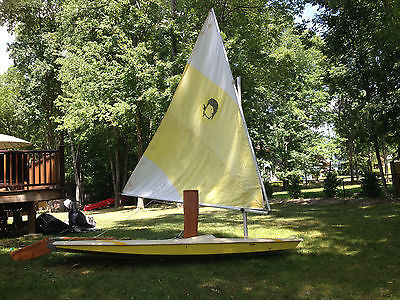
Alcort Mini Fish Sunfish Sailboat
Annandale, New Jersey
Make Alcort
Model Sunfish
Category Sailboats
Length 12.0
This is one fast boat. The sail is that of a Sun Fish, yet this boat is two feet smaller and has a sealed cockpit. It's all there and and ready for fun. Has some usual wear and tear but it does not affect the performance of the boat. This is a wonderful learning boat for kids and it can fit two teenagers.
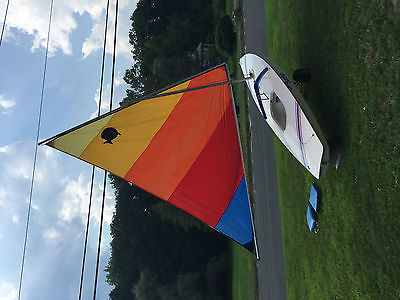
AMF Alcort Sunfish Sailboat with extras
Danbury, Connecticut
Make AMF Alcort
Length 13.9
Used 1982 AMF Alcort Sunfish Sailboat with ExtrasModel: AMF99536M82D This Sunfish was manufactured in December of 1982 in a line of Sunfish manufactured from 1969-1986 by AMF. This boat has only been used in freshwater and has spentmost of its life sitting in a garage between the times itwas used. This listing will include:1982 AMF Alcort Sunfish Sailboat with all parts and accessoriesDaggerboard Dolly w/ wooden stand 2 x blue flotation cushions I will rate all Sunfish Equipment to the best of my ability: Sunfish Hull: 8/10 - still retains original clear coat shinehas a few scuffs and scratches, and has a small paintchip behind the bailer as pictured. Underside has beenbeautifully kept with light scratching but, in overall good shape Lateen Mainsail: 8/10- Sail has 3 small rips as pictured, upper and lower boom are in great shape along with gooseneck mast ring all in good shape. The Mast is in great shape as well, but one sail set is missing. All rigging is included as pictured. Wooden Kick up Rudder and Daggerboard: 9/10 - Both in excellent100% working order. Daggerboard has spring lock in tact and the kick up rudder actually works and is spring loaded. Daggerboard Dolly: Just freshly packed grease into tires , makes iteasy for one person to move the Sunfish around for beach use or self launching. Also has a wooden stand for garage storage. Overall I rate this boat an 8/10 based on its age and condition,you don't really find these boats in this good of condition every day.Hoping it lands in good hands and is used for enjoyment and continuesto be as well maintained as it was in my family. This Sunfish will be pickup-only from Danbury, CT. Pretty central to NY, NJ, RI, MA. Buyer can fully inspect all items before purchase upon pickup.
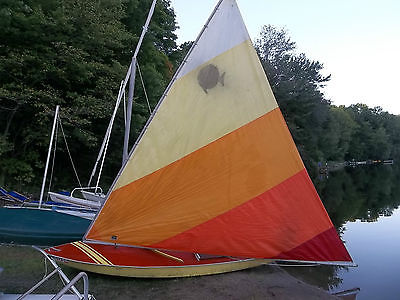
Sunfish Sailboat 2nd Gen.(new style rudder)
Granville, Massachusetts
Length 14.0
Sunfish Sailboat mid 1970's in better than average condition. Have sailed it the last 11 years. An original class legal Alcort 5 panel sail with only 1 cigarette tip size hole, sail it for years to come, Daggerboard and rudder wood is original, but has had many coats of marine varnish put on in the last 2 years. Lines are in good shape, bridle broke so replaced it with a piece of rope, Bow handle is missing a screw and is slightly bent. The deck where the cleat to tie off the sail is cracked, still usable, but needs repair or put a hull inspection port there for $10 on Ebay and move the cleat. Can pickup or view in Tolland,MA Thanks for looking
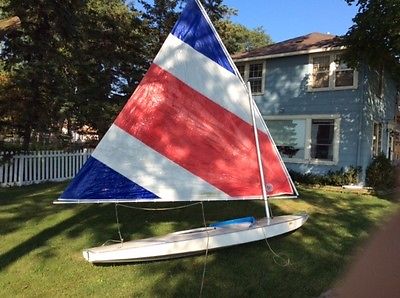
Sailboat AMF Sunfish
Green Bay, Wisconsin
Make AMF Sunfish
Length 14 ft
AMF Sunfish excellent condition
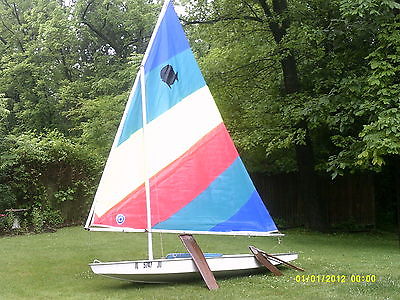
Sunfish AMF Sailboat 1975
Decatur, Illinois
Make Sunfish AMF
Sunfish AMF 1975. This boat is in nice condition showing some wear and tear. It is complete and ready to sail. New sail only used one season. Trailer comes with the boat and both have good titles. Call Dennis if you have any questions 217-855-3457

Zuma/sunfish sailboat
Bechtelsville, Pennsylvania
Selling Zuma sailboat! This Zuma needs some tender loving care and needs to be cleaned up and patched. But after some quick easy patch work and a bath she will be good as new. The sail is hot pink (quite the stunner) and in EXCELLENT condition, looks brand new. Zuma comes with all parts. She's been sitting and was barely ever used. Pickup only, I do not have a trailer to haul her away. Serious buyers only! and NO low ballingThanksLeah
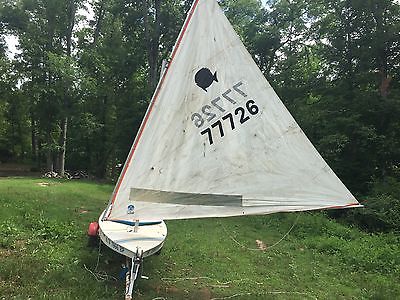
1974 Sunfish sailboat 14'
Knoxville, Tennessee
Model Sailfish
Category Daysailer Sailboats
Great little day sailer. It has a standard dagger board but is missing the brass wedge bracket. Easy to replace. It also has a white racing dagger board. Please see pictures. The sail is more of a racing style than most. This boat really moves. There are a few minor dings here and there. Nothing major. It is ready to sail. Trailer has lights and has good bearings. Will trailer just fine. Please feel free to call with questions. Ray 865.456.6456
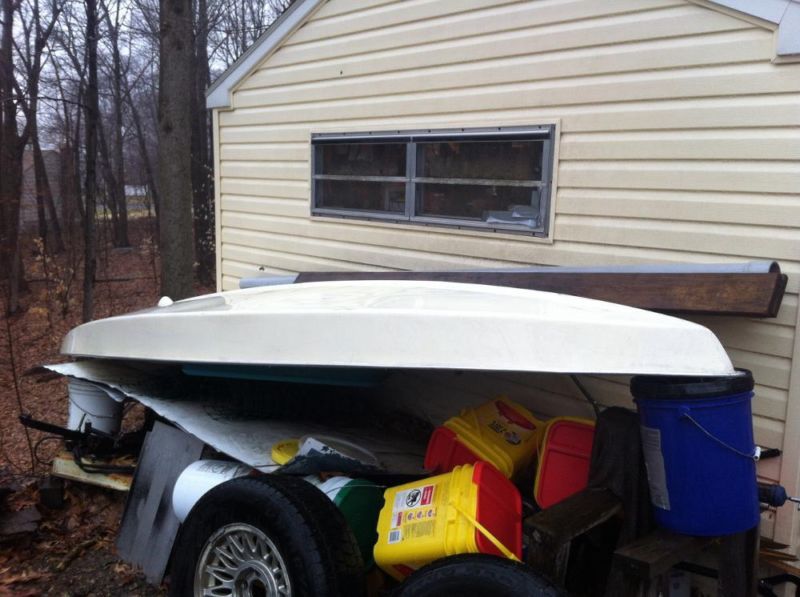
14 Foot Sunfish Sailboat
New York, New York
Fourteen (14) foot Sunfish sailboat in excellent condition. Includes mast, sail, rigging, rudder, and keel board. Price includes two adult life jackets. Call 203-218-9058 to make an offer. Great for the upcoming beach season.
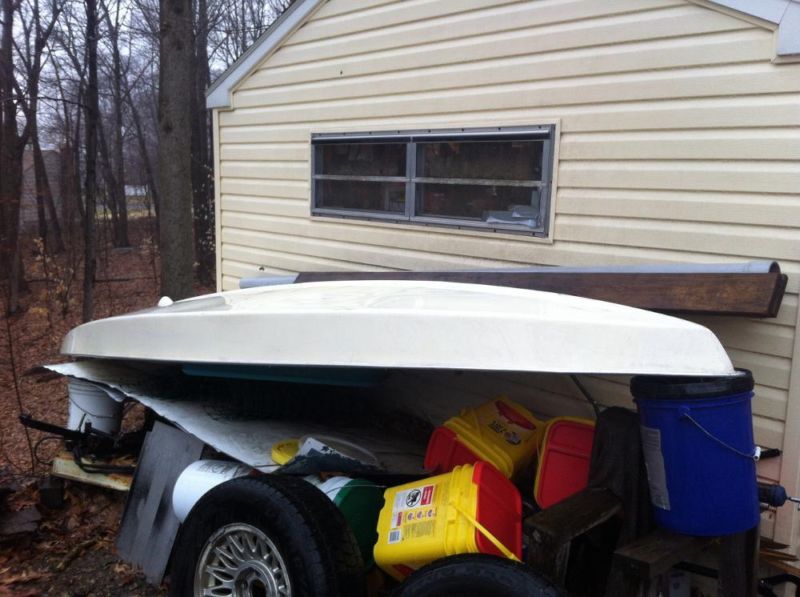
Shelton, Connecticut

AMF Sunfish sailboat
San Marcos, California
Good older Sunfish , A great learner boat for kids and beginners, Comes with hand cart to move it around," NO BOAT TRAILER" ,bring a truck or your own trailer,or stack it on your boat and go racing with friends
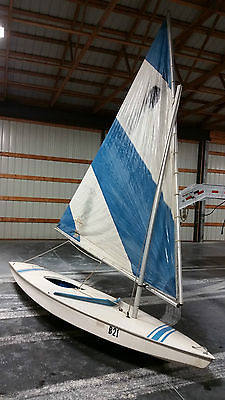
1970s Alcort Sunfish Fiberglass Sailboat - Day Sailer - Novice to Expert Sailor
Warrensburg, Missouri
Midwest Sunfish Sailboat, 1970s! This boat is in overall good shape and has always been kept indoors. The boat has not been cleaned and mild dirt on the sail was not washed prior to pictures. The boat has been in storage for several years and therefore the decision is to let her go to someone who will sail her again. She has been a good, reliable boat and never let us down. The boat has all its parts and accessories except for the centerboard, tiller and rudder... which have somehow been misplaced. The boat has had a mild fiberglass repair on the hull (see pictures) but it does not leak. The sail is in strong condition and also has a few repairs (see pictures). As you can see, rudder/tiller assemblies can be purchased online (new and used) as well as centerboards (new and used). The sail comes with its original bag. Available for local pickup. Shipping might be possible for a fee. Call Jason with any questions 6608646900 Features: The distinctive lateen sail gives the Sunfish an anachronistic appearance. Using a lateen rig for this style boat shifts the advantage toward better performance in lighter air and contributes to it having good down-wind characteristics. The hull’s very mild "V" bottom and hard chine make Sunfish a most stable boat for its size, along with enabling it to sail on a plane. Planing allows the boat to achieve a speed greater than theoretical hull speed based on length at waterline. Having a down-wind performance advantage helps the Sunfish to achieve a planing attitude at lower wind speeds. Designed as a water-tight, hollow-body pontoon, a hull like the Sunfish has is sometimes referred to as "self-rescuing" because the boat can be capsized and its cockpit swamped without threat of the boat sinking. Sunfish Boat Specifications LOA: 13\'9" Beam: 4\'1" Draft: 2\'11" Sail Area: 75 Square Feet Hull Weight: 120 Pounds Capacity: 1-2 people Skill Level: Beginner-Expert Race Level: Club International Optimal Weight: upto 190 pounds Transport: Car top carrier, hand dolly, over-the-road trailer The sailplan requires just 2 lines to control and the boat can be set up in less than 5 minutes. The patented kick-up rudder system allows full beach landings with no problems. The hard-chined hull and low sail plan provide unmatched stability and a forgiving feel. The Sunfish hull is light enough to throw on top of your car with ease. The Sunfish combines performance, stability and durability in a package that appeals to beginners and experts alike. If it's racing you crave, the International Sunfish Class has a full time staff that sanctions more than 1000 events each year. Add the hundreds of local and regional events to that list and you can stay pretty busy racing your Sunfish. The class will keep you posted with its quarterly magazine "Windward Leg" and provide valuable performance tips. The elegant simplicity, performance, and intelligent economy of the Sunfish is unmatched. The Sunfish enjoys fantastic resale value. Highlights: Convenient storage in the back of cockpit which is perfect for extra gear or a cooler Patented kick-up rudder makes beach launches, landings, and shallow-water sailing effortless. Self-bailing cockpit Hydrodynamic daggerboard maximizes upwind performance. Lateen rigged sail: 1.) automatically depowers when hit by a gust of wind 2.) two sides of the sail are supported which ensures durability 3.) easy to rig and derig Mainsheet is the only control line that you need to use to enjoy the simple pleasures of sailing a Sunfish. Simple main halyard is one of the two lines on the Sunfish, it hoists and lowers the sail in a matter of seconds, enabling spontaneous enjoyment of the water Stainless steel bow handle: facilitates carrying, docking, and holding the boat into the wind while launching or loading
1972 AMF ALCORT Sunfish Sailboat
Prospect, Kentucky
Purchased new in 1972, single owner - sailed for 10 years, stored for 30 years. Everything is original, complete, and in good condition. Mahogany rudder/tiller and center board are like new. Tee Nee Trailer has new high speed tires and rims, and a new trailer hitch. Would like to get it out of the yard. Its on the trailer and ready to go. Come see it - bring cash and tow it away - the trailer takes a 1 and 7/8" ball.$ 900.00
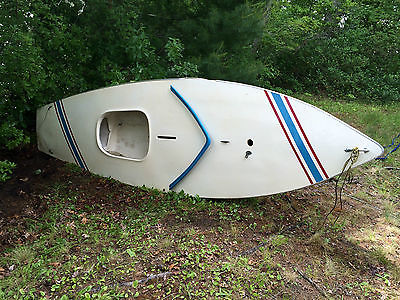
Alcort Sunfish Sailboat Boat, Mast, Sail, ropes, Rudder, and 2 Centerboard s
Mashpee, Massachusetts
Make Alcort Sunfish
Model Alcort Sunfish
I paid $1,575 for this boat 7 years ago. It had sat in someones garage for 30 years. It was in fantastic shape when I bought it. It was used 2 times the first year I got it. I had grown up sailing a sunfish and bought it hoping I would use it a lot at the lake in Mashpee Massachusetts summer cottage where it has been stored. It has been stored year round underneath tarps completely covered year round. This sale includes the boat, the sail, the ropes, the mast, 2 centerboards, and the rudder. The rudder was missing the last segment when I bought it-the part you hold on to, so I invented a last segment which worked fine for me. One centerboard is in great shape, the other in ok shape. The one piece of damage is seen clearly in the photos- one piece of metal strapping has peeled away from the edge. I am sure someone who knows what they are doing can bend it back. I would rather not attempt it myself. It was watertight when I sailed it. It is sold as is.It is a great deal.Cape Cod Mashpee on the shore of a lake.
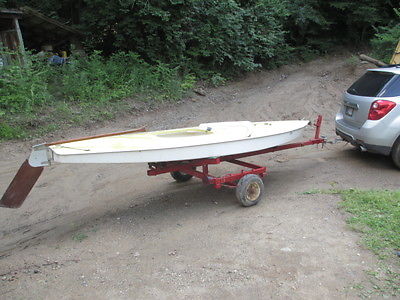
1972 Sunfish sailboat 14' good sail with trailer new wheel tire hitch no mast
West Lafayette, Indiana
Length 14 feet
This is a Sunfish sailboat 14' with trailer. The boat is from 1972. A clear title comes with the trailer. It has a new wheel, tire and hitch with 1 7/8" socket. The sail is in good condition and has the emblem of the black sunfish on it. The two aluminum booms are both there, however the main mast is missing. It has some cosmetic scratches around the seating area, which can be filled in. Pictures of the rudder and the back of the boat show the metal hooks to attach the rudder, which is made of mahogany wood and aluminum. Though I have sailed this boat for many years, but not lately, I forgot how to attach it. The tiller does not have the extension, but it can be easily added. The sail is complete with aluminum booms and pulleys etc. The dagger board is included, as well as an extra paddle. Will Ship Worldwide.
Narrow Results
Current search reset all.
- Keyword: sunfish sailboat
- Alcort Sunfish (2)
- Laser Performance (2)
- AMF Alcort (1)
- AMF Sunfish (1)
- Force 5 (1)
- Skipper (1)
- Sunfish AMF (1)
- Daysailer Sailboats (7)
- Sailboats (2)
- Cruiser Boats (1)
- Racer Boats (1)
- New York (7)
- Connecticut (2)
- Florida (2)
- Georgia (2)
- Massachusetts (2)
- North Carolina (2)
- California (1)
- Illinois (1)
- Indiana (1)
- Kentucky (1)
- Missouri (1)
- New Jersey (1)
- New Mexico (1)
- Pennsylvania (1)
- Tennessee (1)
- Wisconsin (1)
- Search Title Only
- Has Picture
- Include Sold Listings
Showcase Ads

2001 Sea Fox 257CC
Edgewater, FL

2005 Formula 400SS
El Lago, TX

2005 Contender 21 contender
Boca Raton, FL

2004 Malibu Wakesetter Lsv 23
Sacramento, CA

2001 Grady-White Chase 263
Gonzales, LA

1989 Sea Ray 390 Express Cruiser
Sarasota, FL

1989 Performance Fiberglass 21' Gene Built
Savannah, TN
Create Alert
Please, name this search
Select Interval
Alert Successfully Created
Great choice! Your favorites are temporarily saved for this session. Sign in to save them permanently, access them on any device, and receive relevant alerts.
- Sailboat Guide
1968 AMF Alcort Sunfish
- Description
Seller's Description
This is a vintage, 1960’s Sunfish Sailboat Project. Some TLC and basic restoration skills will have this puppy happily sailing again. I began restoring it, purchasing a professionally restored mahogany rudder, tiller and daggerboard in 2021 and fiberglassing one of two small punctures sustained from a falling branch during a winter storm. The boat was sailed as recently as 2020. The sail is functional but word. I halted the project when I lost patience and had the opportunity to buy a fully restored, more recent model.
Rig and Sails
Auxilary power, accomodations, calculations.
The theoretical maximum speed that a displacement hull can move efficiently through the water is determined by it's waterline length and displacement. It may be unable to reach this speed if the boat is underpowered or heavily loaded, though it may exceed this speed given enough power. Read more.
Classic hull speed formula:
Hull Speed = 1.34 x √LWL
Max Speed/Length ratio = 8.26 ÷ Displacement/Length ratio .311 Hull Speed = Max Speed/Length ratio x √LWL
Sail Area / Displacement Ratio
A measure of the power of the sails relative to the weight of the boat. The higher the number, the higher the performance, but the harder the boat will be to handle. This ratio is a "non-dimensional" value that facilitates comparisons between boats of different types and sizes. Read more.
SA/D = SA ÷ (D ÷ 64) 2/3
- SA : Sail area in square feet, derived by adding the mainsail area to 100% of the foretriangle area (the lateral area above the deck between the mast and the forestay).
- D : Displacement in pounds.
Ballast / Displacement Ratio
A measure of the stability of a boat's hull that suggests how well a monohull will stand up to its sails. The ballast displacement ratio indicates how much of the weight of a boat is placed for maximum stability against capsizing and is an indicator of stiffness and resistance to capsize.
Ballast / Displacement * 100
Displacement / Length Ratio
A measure of the weight of the boat relative to it's length at the waterline. The higher a boat’s D/L ratio, the more easily it will carry a load and the more comfortable its motion will be. The lower a boat's ratio is, the less power it takes to drive the boat to its nominal hull speed or beyond. Read more.
D/L = (D ÷ 2240) ÷ (0.01 x LWL)³
- D: Displacement of the boat in pounds.
- LWL: Waterline length in feet
Comfort Ratio
This ratio assess how quickly and abruptly a boat’s hull reacts to waves in a significant seaway, these being the elements of a boat’s motion most likely to cause seasickness. Read more.
Comfort ratio = D ÷ (.65 x (.7 LWL + .3 LOA) x Beam 1.33 )
- D: Displacement of the boat in pounds
- LOA: Length overall in feet
- Beam: Width of boat at the widest point in feet
Capsize Screening Formula
This formula attempts to indicate whether a given boat might be too wide and light to readily right itself after being overturned in extreme conditions. Read more.
CSV = Beam ÷ ³√(D / 64)
Although the earliest models were built of wood and offered as kits, the fiberglass version, first introduced in 1960, became the most popular recreational sailboat in history. As a result, there were many imitators.
Sunfish Builder Chronology 1952 - 1969 Alcort, Inc. (founded 1945) 1969 - 1986 AMF 1986 - 1988 Loveless & DeGarmo, dba, Alcort Sailboats Inc. 1988 - 1991 Pearson Yacht Co. 1991 - 1997 Sunfish/Laser, Inc. 1997 - 2007 Vanguard 2007 - Laser Performance Change in class rules permitted a new, slightly deeper daggerboard in the mid-1990’s.
This listing is presented by SailboatListings.com . Visit their website for more information or to contact the seller.
View on SailboatListings.com
Embed this page on your own website by copying and pasting this code.
- About Sailboat Guide
©2024 Sea Time Tech, LLC
This site is protected by reCAPTCHA and the Google Privacy Policy and Terms of Service apply.
JavaScript seems to be disabled in your browser. For the best experience on our site, be sure to turn on Javascript in your browser.
- Compare Products ( )
- Create an Account


Designed by Alex Byran and Cortlandt Heyniger in 1953 and originally built out of plywood, the Sunfish® is the world’s most popular sailboat, with more than a quarter-million sold by 1995 when it was inducted into the American Sailboat Hall of Fame.
The legendary dinghy’s construction switched from plywood to fiberglass in 1960, and incremental refinements have been introduced over the years. Today’s Sunfish® is essentially identical to the ones that were sailed hard and put away wet back in the 1960s. The net result is an international class that sanctions more than 1,000 regattas a year and a design that’s as equally suited to racing as it is to day sailing.
- Single-line sheeting dramatically simplifies sail rigging and handling.
- Lateen rig will twist-off and depower in gusts.
- Self-bailing cockpit helps keep the cockpit/footwell dry.
- Aft cockpit space accommodates small cooler for outings with friends.
- Deck coaming provides protection when negotiating choppy waters.
- Optional Race package includes race-ready sail with visibility window and additional sail controls to fine tune sail shape. Call us for details and availability.

FREE SHIPPING POLICY
Free shipping on all orders over $99. Does not apply to over-sized items or Hobie items. We consider over-sized items to be any sailboats, kayaks, paddle-boards, and anything over 40" in length. Learn more about our shipping policy by clicking here .


How Much Do Sunfish Sailboats Cost? 2 Examples (With Pictures)
If you are new to sailing or want to get started, dinghy sailing at your local yacht club is a great way to begin.
Many yacht clubs have a fleet of small sailing boats to teach people to sail. The Sunfish design fills this niche as an easy and fun boat for both novices and experienced sailors alike.
The Sunfish sailboat was originally designed in 1952 and is still considered one of the most iconic sailboats ever made.
You can find these small sailboats on waterways, lakes, and bays as recreational boats all over the USA, in addition to racing fleets all over the world.
Here’s a Summary of Sunfish Sailboats:
A Sunfish is a small sailboat capable of carrying one or two easy-to-launch off a beach. The Sunfish features a flat, board-like hull combined with a simple rigging designed for ease of use and comfortable, hassle-free sailing.
Table of Contents

The History of Sunfish Sailboats
Sunfish was started by two childhood friends, Alexander Bryan and Cortlandt (Bud) Heyniger, who created Alcort, Inc (the Al and the Cort of the company name).
In 1959 the two friends discovered fiberglass, and then the company created molds for the Sunfish, and production started on a grand scale. The new fiberglass boats were lighter, faster, and much better looking than before, resulting in close to 10,000 a year for almost 20 years.
The Sunfish was the first one-design boat that the manufacturer rigidly controlled. Even the sails were limited to one sail loft, and there was very little that could be changed to add go-faster accessories.
The boats were designed to be simple, with no need to buy a new set of sails every year and no need to keep buying or changing expensive equipment to keep up with the latest sailing trends.
Because of their low price point and their low maintenance, the Sunfish sailboat made sailing popular amongst the masses. A Sunfish is trailerable, is easy to launch and easy to sail, and can be used by the whole family.
While these boats have their own class for racing, they are also used for teaching sailing to people of all ages.
The two friends sold the company to an American company, the American Machine and Foundry Co (AMF), in 1969. After which the company has been sold several times.
Nowadays, Sunfish sailboats are manufactured by Laser Performance who has a production facility in China. In 1995, the Sunfish was inducted into the American Sailboat Hall of Fame.
The design was recognized as “the most popular fiberglass boat ever designed, with a quarter of a million sold worldwide.”
How Much Do Sunfish Sailboats Cost?
So, we have mentioned that the Sunfish sailboats are extremely affordable and popular, but how much do Sunfish sailboats actually cost?
Here we give a selection of both new and second-hand models:
New Sunfish Sailboats:
There are still many dealers of Sunfish sailboats both in the USA and abroad, and Laser Performance is still the current manufacturer, so new boats are widely available.
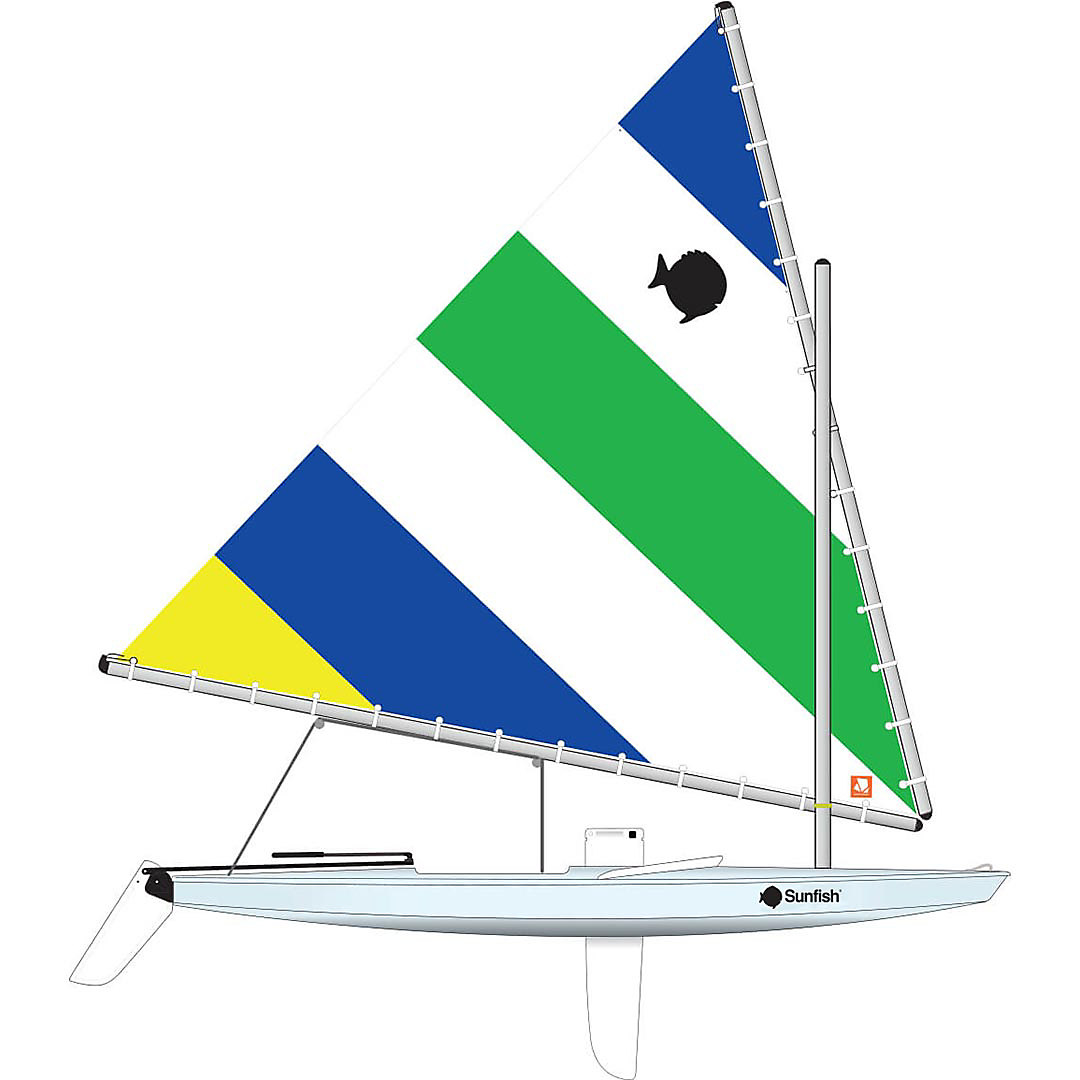
Image: laserperformance.us
Prices direct from Laser Performance start from $4,629.25.
However, many dealers keep stock of Sunfish sailboats, so if you shop around, you may be able to find a new Sunfish sailboat for a better price.
A quick search on the internet found an online shop, the Dinghy Shop, offering new Sunfish sailboats for $4,356.00, which saves nearly $300.
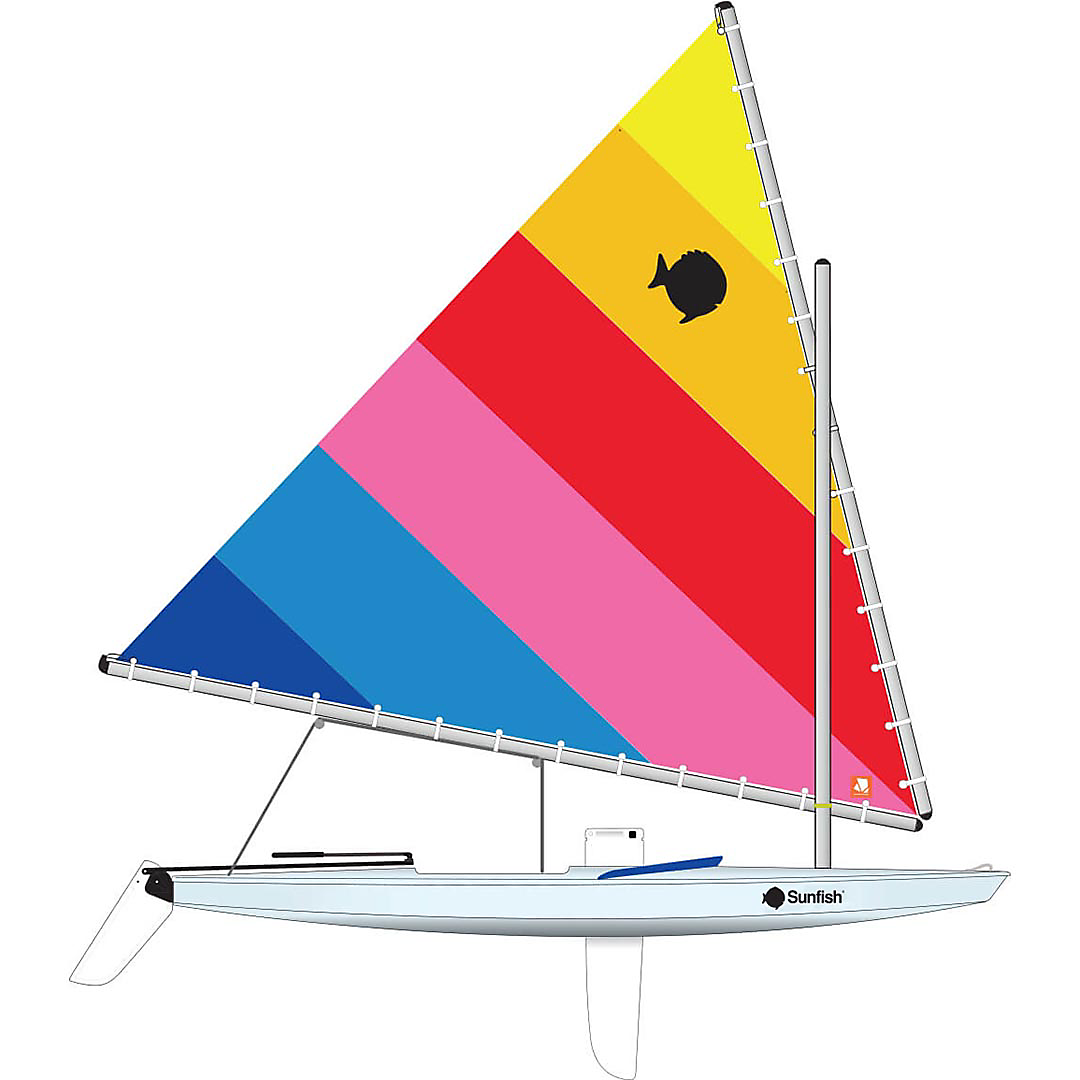
Second-Hand Sunfish Sailboats:
Second-hand Sunfish sailboats are widely available and will usually cost between $900 and $1,200 for a used boat in good condition.
Things to look for when buying a second hand or used Sunfish sailboat include the following:
- The hull should look smooth, with no holes, gauges, or deep imperfections.
- The hull should be uniformly firm and not soft in places.
- Look for boats that have been ‘dry sailed.’ This means that the boat has been stored on land, off the ground, and under a good covering when it is not being sailed.
- If a boat is left in the water or improperly stored, boats will absorb water and gain weight quickly.
- The weight of the boats should be low or as close to the manufacturer’s specified dry weight as possible.
- If you want to race and be competitive, a second-hand Sunfish should be avoided unless it is close to the weight of a new boat.
If a boat is sailed often, the sails will lose their effectiveness for racing after a year or two.
However, they will still be good for day sailing and training. Competitive racing requires newer sails that still feel crisp and have their shape.
New Sunfish sails retail for around $400.
Some other things to look out for or how to tell if an owner has taken good care of a boat include the following:
- The sails will be rolled and not folded;
- The boat is kept clean;
- The boat is stored out of the water, off the ground, dry, and covered.
One of the best places to look for a used Sunfish sailboat is on the Sunfish Sailing Forum. There you will find boats, trailers, and spare parts in all corners of the US.
While the Sunfish sailboat was a proudly American design, the boats can be found worldwide.
There are dealers on every continent, and as they are light, they can be shipped worldwide.
Sunfish Sailboat Specifications:
Here are a few specifications you might need to know before buying:
- Length – 14’9″/
- Beam – 4’1″/1.25M
- Draft – 2’11″/0.64M
- Sail Area – 75FT²/6.97M²
- Hull weight – 120 pounds/59kg
- Capacity – 1 to 2 people
- Skill Level – Beginner to Expert
Final Thoughts
While the two original designers didn’t realize how popular the Sunfish would become, they managed to invent a boat that everyone could sail.
It didn’t matter about your age, gender, or your skill level. Plus, this simple design was affordable to many.
Despite being sold to various companies over the years, the design has remained unchanged. While the present builder, Laser Performance, has moved the production to China, they are still very widely available.
In addition, the Sunfish class is recognized as a One Design racing class all over the world.
So, if you are looking for an affordable and fun way to get out on the water, you won’t go wrong with a Sunfish.
References:
Sunfish: The True Love Boat – Scuttlebutt
Sunfish – Laser Performance
Saling Forums – Sunfish
Click to share...

IMAGES
VIDEO
COMMENTS
Sunfish Sailboat (Niagara River, Buffalo, New York; 1970) Children learning to sail in Dunewood, New York ... For the 1960 model year, Sunfish became available in a fiberglass version for the first time. Alcort shop-built wood boats were phased out around the same period, however, the Sunfish kit boat remained available through the late 1960s. ...
Although the earliest models were built of wood and offered as kits, the fiberglass version, first introduced in 1960, became the most popular recreational sailboat in history. As a result, there were many imitators. Sunfish Builder Chronology 1952 - 1969 Alcort, Inc. (founded 1945) 1969 - 1986 AMF 1986 - 1988 Loveless & DeGarmo, dba, […]
Maniac. This afternoon we finally did it: opened up our old 1960 Sunfish and pre-72 AMFlite 14. Prior to the cutting, we figured Old Blue (Sunfish) was damp and heavier, though she sailed fine (as far as we could tell). The AMF was significantly lighter, but had noticeable flex in the hull and some chips in the hull.
1960 2500 - 2900 • Fiberglass Sunfish introduced - • LOA 13'-10", Beam 48½", Weight 139 lbs. Sail 75 sq ft. 1961 2900 - 3400 1962 3419 - 5692 ... • Sunfish inducted into The American Sailboat Hall of Fame, credited with over a quarter million Sunfish built. 1996 SLI54321C6 96
Although the earliest models were built of wood and offered as kits, the fiberglass version, first introduced in 1960, became the most popular recreational sailboat in history. As a result, there were many imitators. Sunfish Builder Chronology. 1952 - 1969 Alcort, Inc. (founded 1945)
It's also the most popular sailboat ever made, with more than half a million built since the first launch in 1952. The design of the Sunfish came from Cortlandt Heyniger and Alex Bryan, friends ...
The Sunfish debuted in 1951 as an evolution of the Sailfish, built first of wood. The fiberglass model debuted in 1960 and weighed barely 100 pounds rigged. It carried a 75-square-foot mainsail and had a planing hull that added speed and excitement. The lateen sail — with its distinctive Sunfish logo designed by Heyniger — made the boat ...
The Minifish is a smaller, shallower Sunfish for $895 and is only mildly successful, as is the Puffer, a 12½-foot day-sailer for $1,995; a 15-foot model is in the works. The Sunbird, a day-sailer ...
Rigging the Sunfish sailboat involves the following steps: - Attach the mast to the mast step on the boat's deck. - Connect the boom to the mast and secure it with a boom vang. - Slide the daggerboard into the daggerboard trunk and secure it. - Attach the rudder to the rudder gudgeons at the back of the boat.
Your search returned 19 matches of 103714 sailboats posted to date Sort by: Length Year Price Added Laser or Sunfish Trailer with Seitech Padded Racks for Two Sailboats
The SUPER SAILFISH was produced in fiberglass in 1959 and the SUNFISH manufacturing process was changed over to fiberglass in 1960. The SAILFISH was phased out in 1962, and the SUPER SAILFISH a few years later. Alcort stopped selling kits in the mid-60s. By 1982 over 200,000 SUNFISH had been sold.
This is a vintage, 1960's Sunfish Sailboat Project. Some TLC and basic restoration skills will have this puppy happily sailing again. I began restoring it, purchasing a professionally restored mahogany rudder, tiller and daggerboard in 2021 and fiberglassing one of two small punctures sustained from a falling branch during a winter storm.
The Sunfish sailboat, known for its simplicity, affordability, and ease of use, can be prepared by following these steps. It was designed by Alcort, Inc. in the United States during the early 1950s and has gained popularity ever since. The design of the Sunfish sailboat has remained largely unchanged, with minor modifications made for better ...
The 14-foot Sunfish sailboat is a popular daysailer that has been around for decades and remains the almost perfect sailboat for pros and beginners. ... the original fiberglass Sunfish introduced in 1960 has not changed much in the half-century since. Over 300,000 have been built by seven manufacturers over the years, a phenomenal number for ...
The Sailfish had a beam of 31-1/2″, a crew capacity of 300 lbs, and weighed 82 lbs. The volume of air enclosed by the hull and deck made the boat virtually unsinkable. A 65-square-foot lateen sail provided ample power. The authors' Super Sailfish, ZSA ZSA, is their restoration of a wooden boat built in the 1950s.
Small sailboats are generally under 20 feet in length, come in a variety of designs, and have different hulls. These include monohulls, catamarans, and trimarans. As long as they have a mast, rudder, sail, and are under 20 feet, it is considered a small sailboat. According to experienced sailors that use a smaller boat, it is best to have one ...
Length 13.9. Posted Over 1 Month. Used 1982 AMF Alcort Sunfish Sailboat with ExtrasModel: AMF99536M82D This Sunfish was manufactured in December of 1982 in a line of Sunfish manufactured from 1969-1986 by AMF. This boat has only been used in freshwater and has spentmost of its life sitting in a garage between the times itwas used.
This is a vintage, 1960's Sunfish Sailboat Project. Some TLC and basic restoration skills will have this puppy happily sailing again. I began restoring it, purchasing a professionally restored mahogany rudder, tiller and daggerboard in 2021 and fiberglassing one of two small punctures sustained from a falling branch during a winter storm.
Designed by Alex Byran and Cortlandt Heyniger in 1953 and originally built out of plywood, the Sunfish® is the world's most popular sailboat, with more than a quarter-million sold by 1995 when it was inducted into the American Sailboat Hall of Fame.. The legendary dinghy's construction switched from plywood to fiberglass in 1960, and incremental refinements have been introduced over the ...
The Dolphin 15 Senior is a recreational sailboat, built predominantly of fiberglass. It has a lateen rig, a spooned, raked stem, a vertical transom, a rounded, transom-hung rudder controlled by a tiller and a retractable fiberglass daggerboard. The rudder is fiberglass, with an aluminum head. The boat displaces 170 lb (77 kg).
Prices direct from Laser Performance start from $4,629.25. However, many dealers keep stock of Sunfish sailboats, so if you shop around, you may be able to find a new Sunfish sailboat for a better price. A quick search on the internet found an online shop, the Dinghy Shop, offering new Sunfish sailboats for $4,356.00, which saves nearly $300.
Sailfish (sailboat) The Sailfish sailboat is a small, hollow body, board-boat style sailing dinghy. The design is a shallow draft, sit-upon hull carrying a crab claw sail mounted to an un- stayed mast. This style sailboat is sometimes referred to as a "wet boat" because, with its minimal freeboard, the sailor often gets splashed by spray as the ...